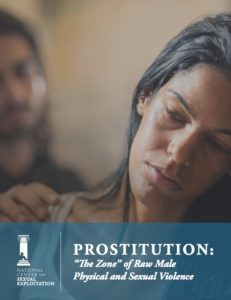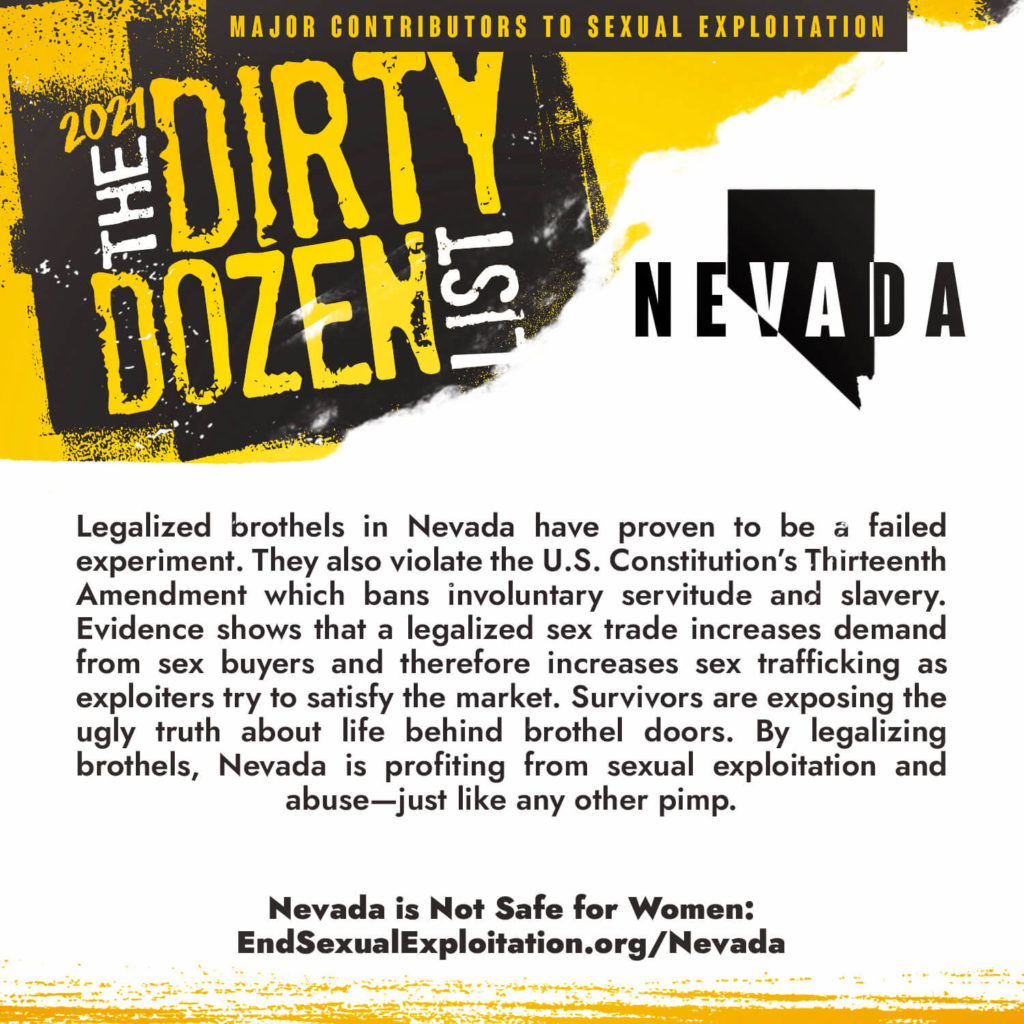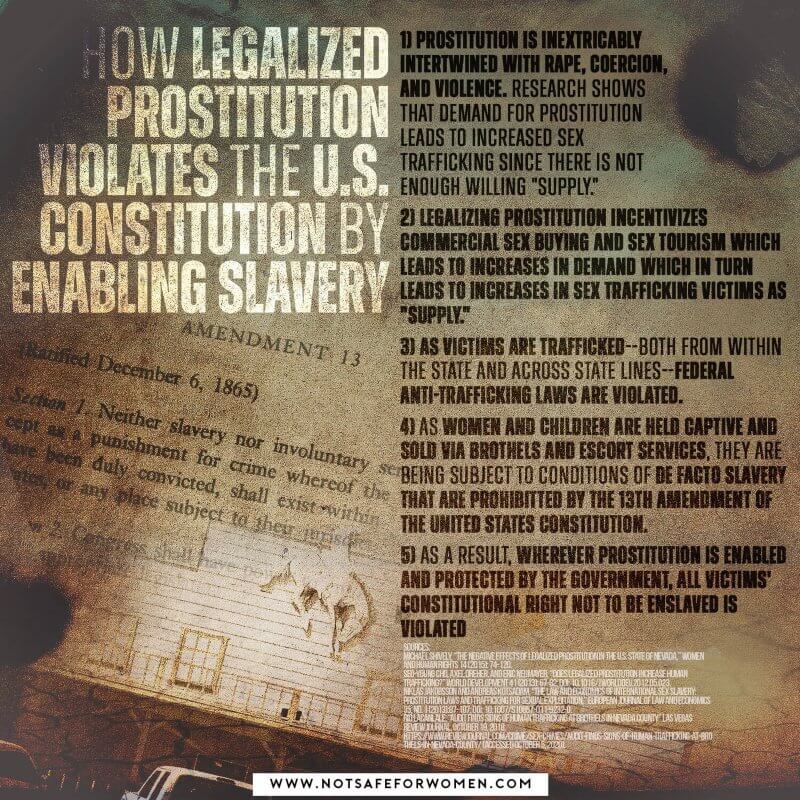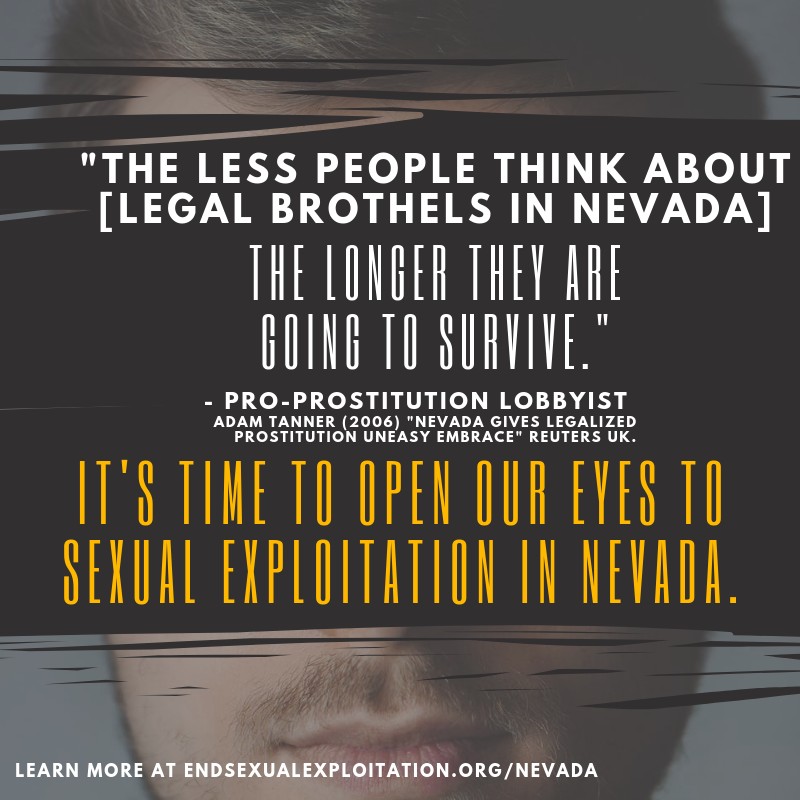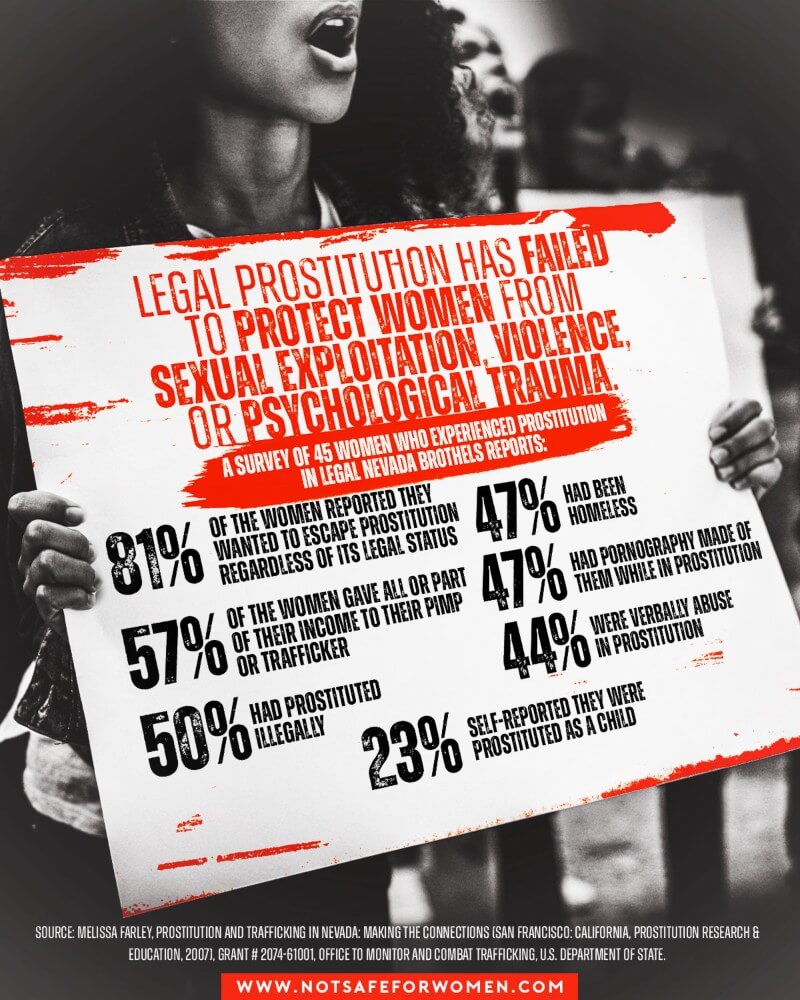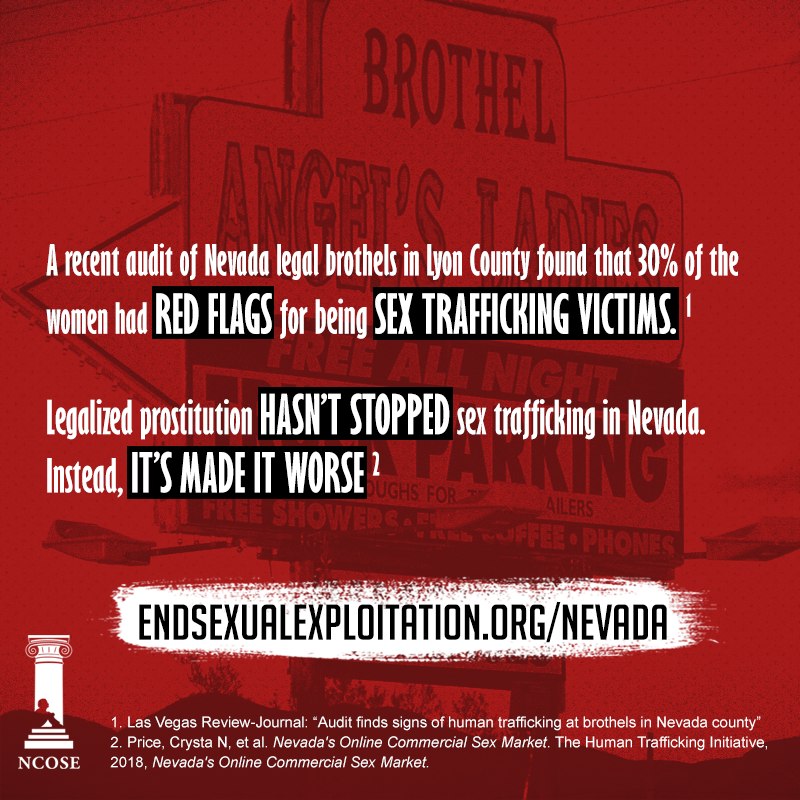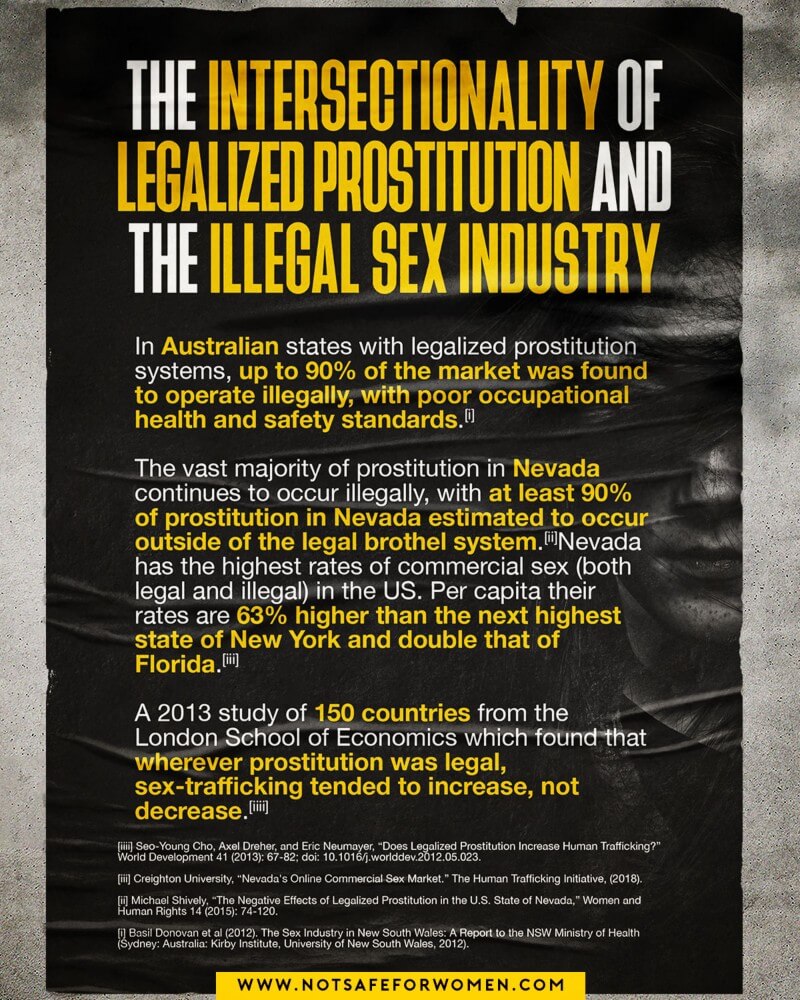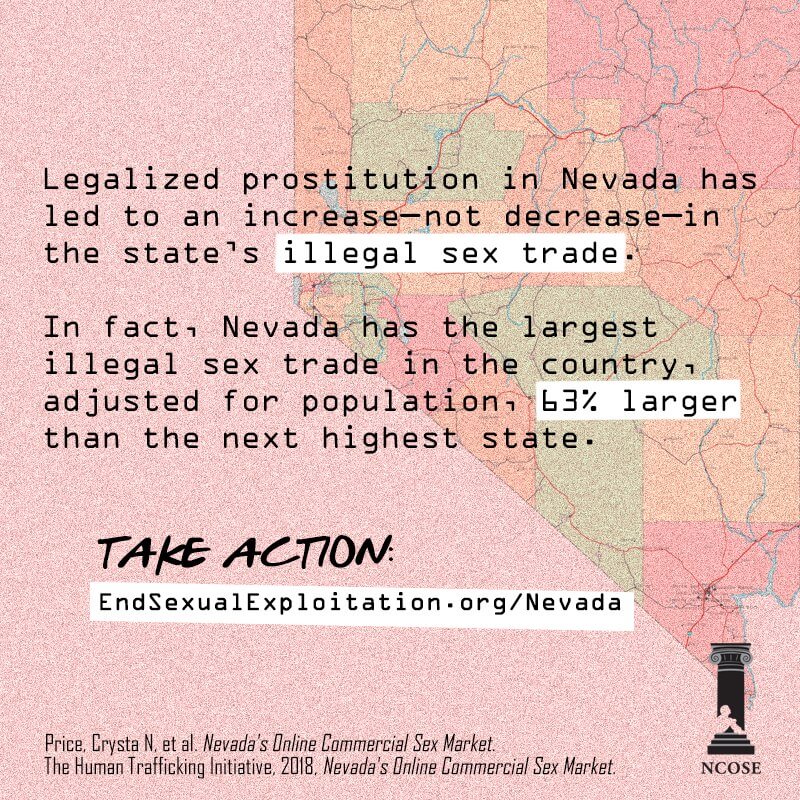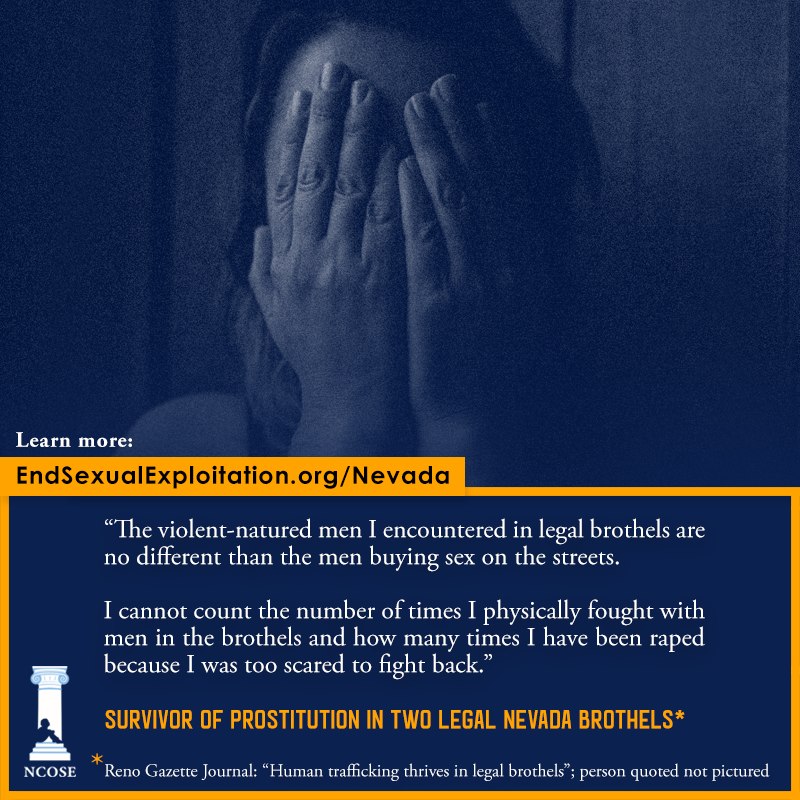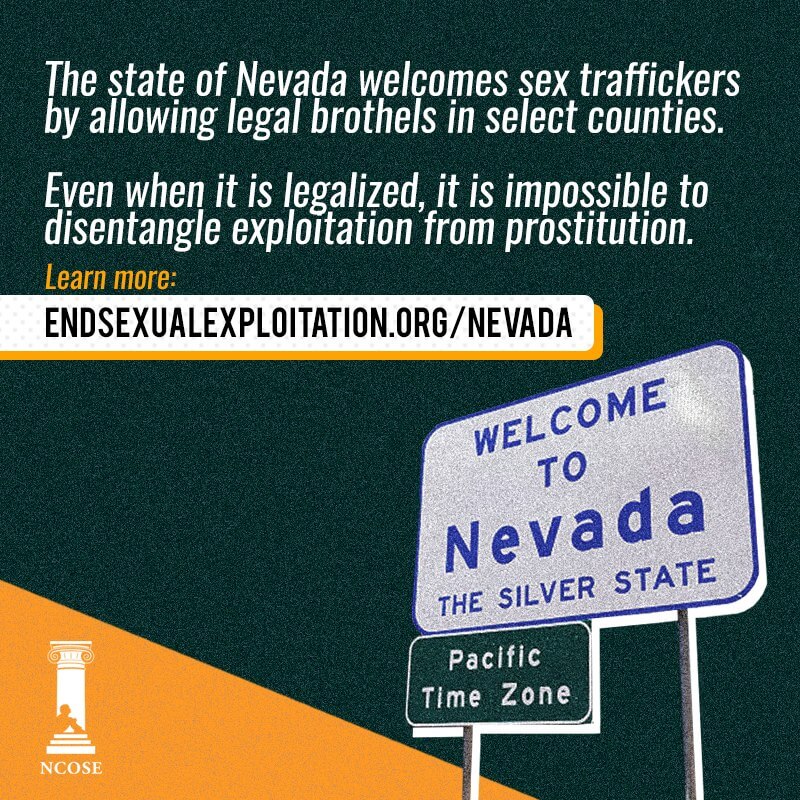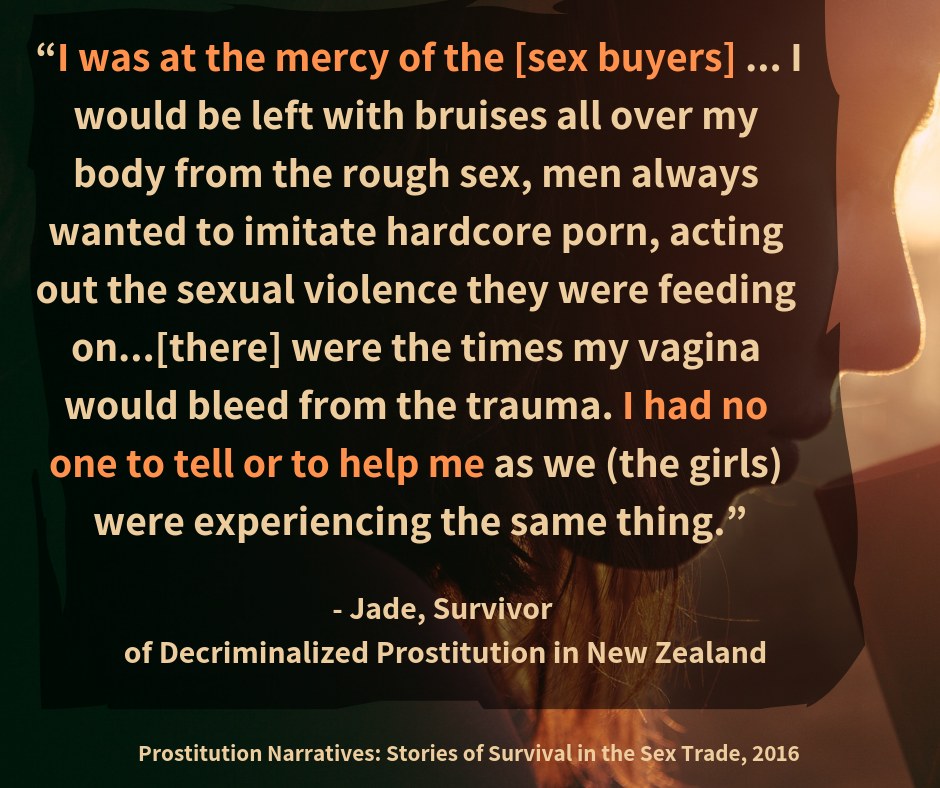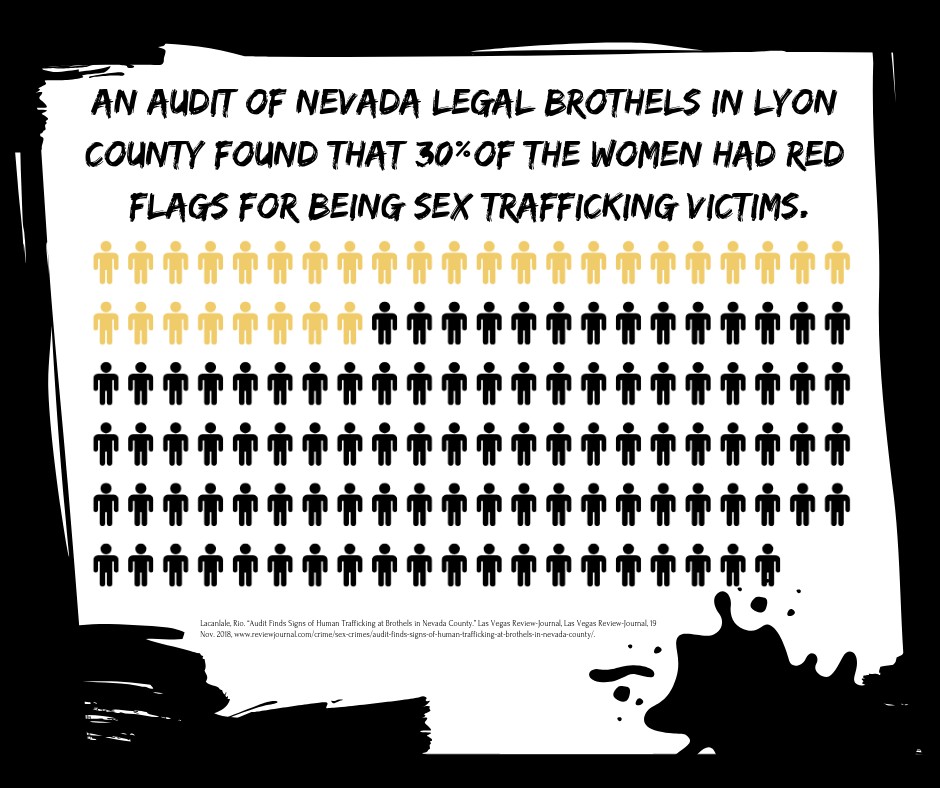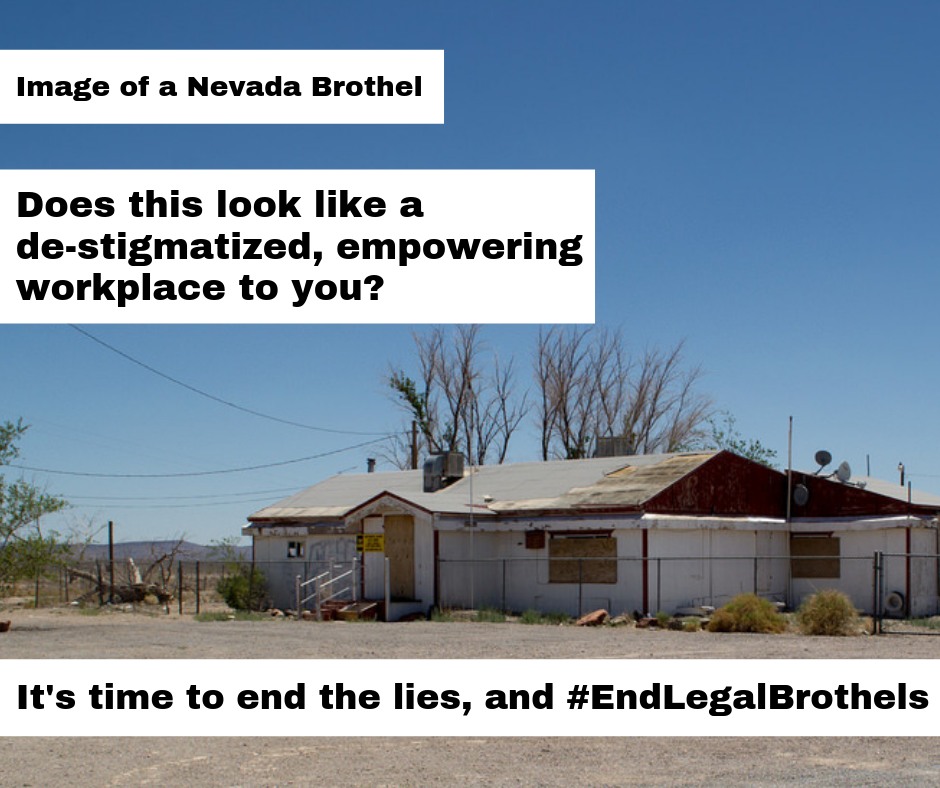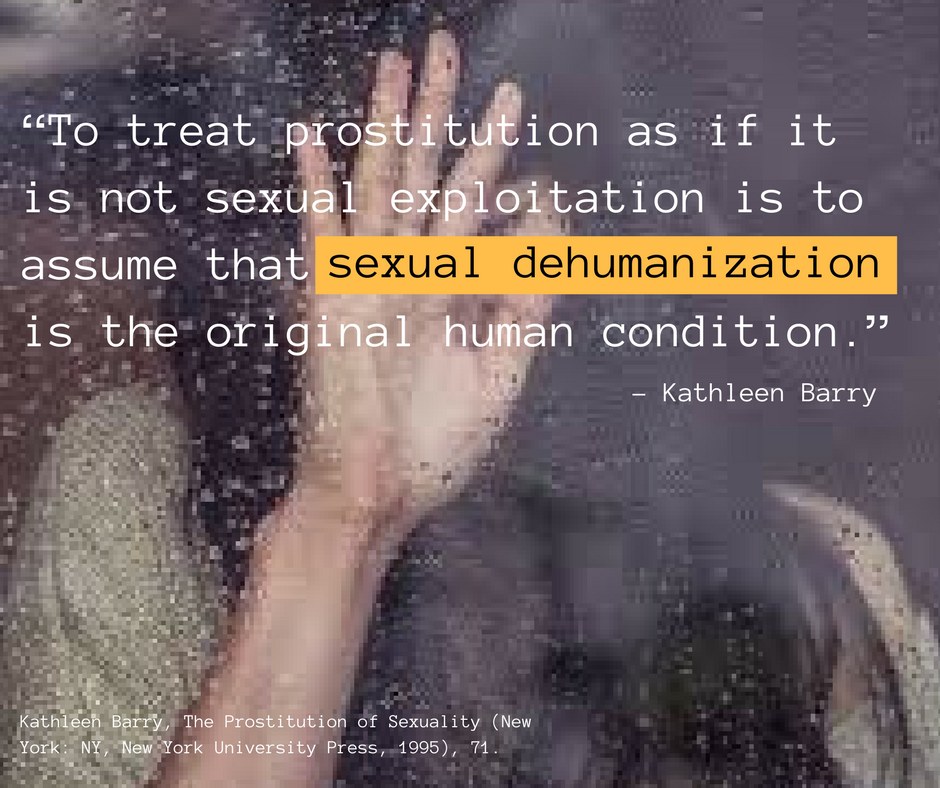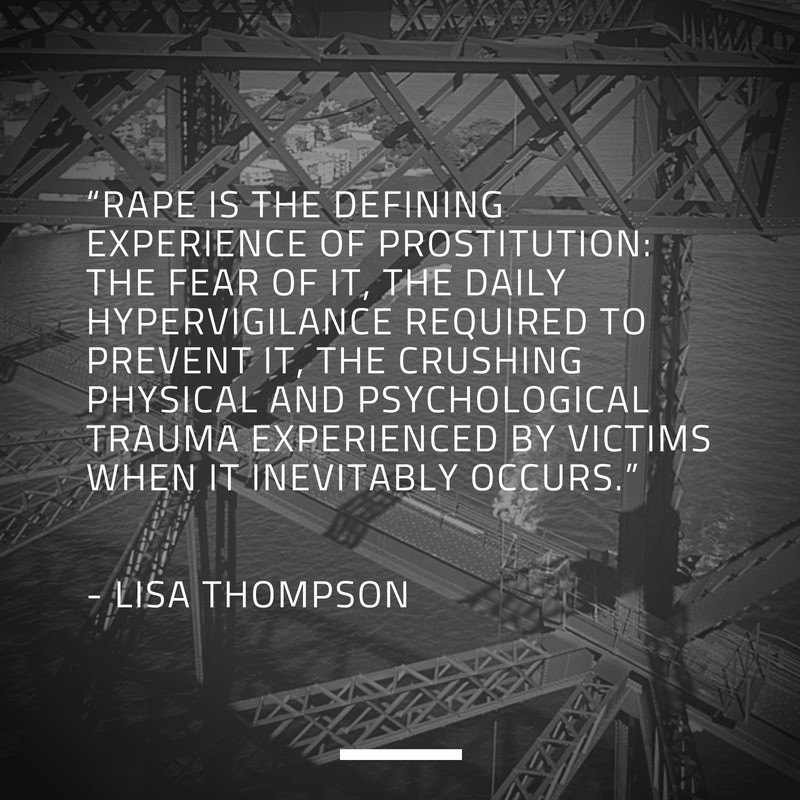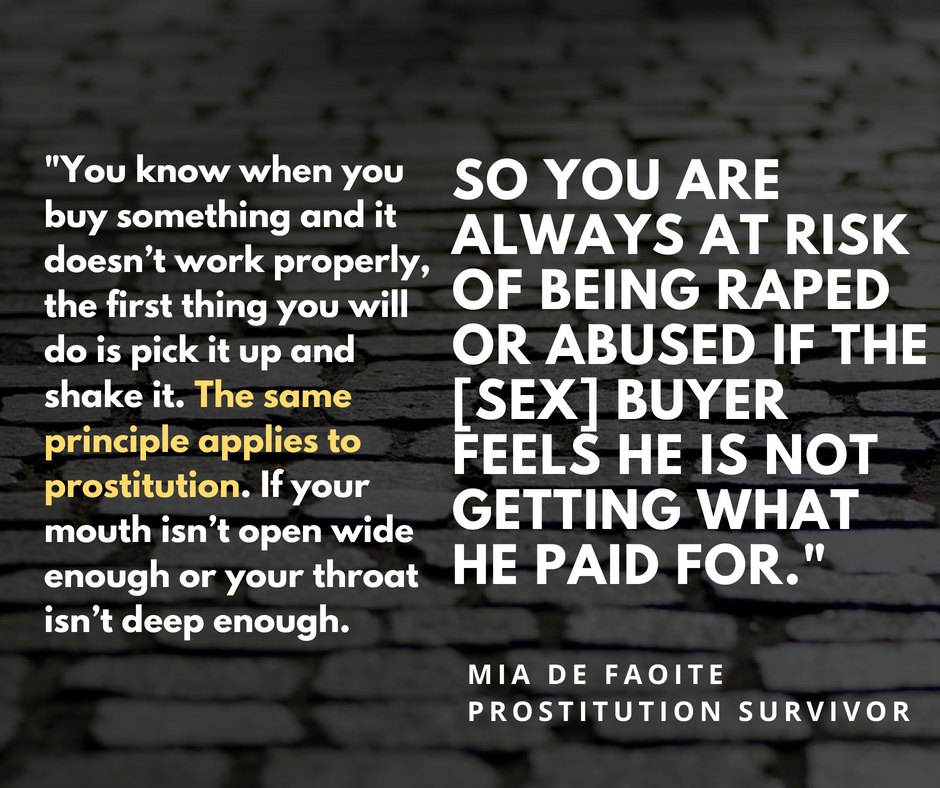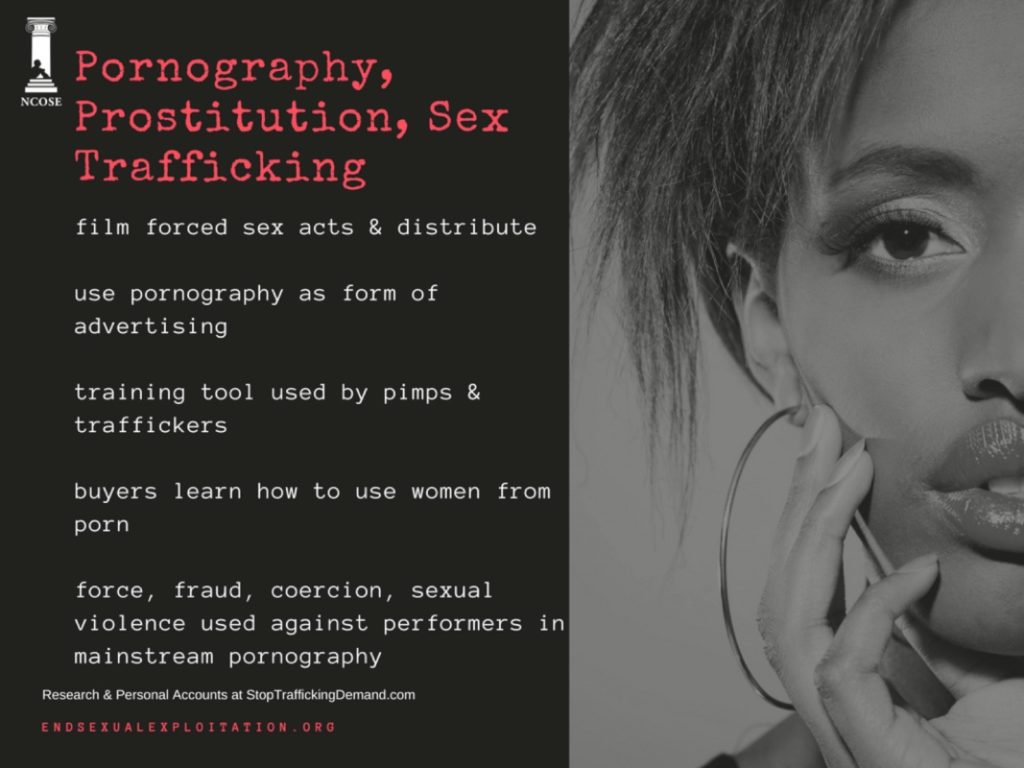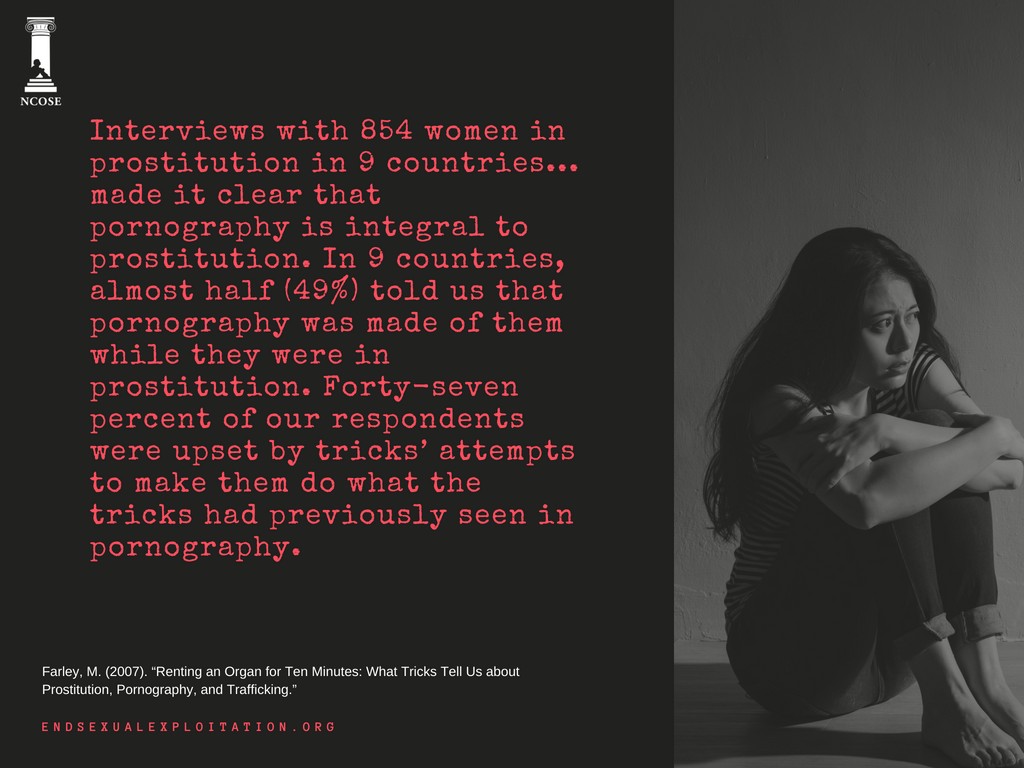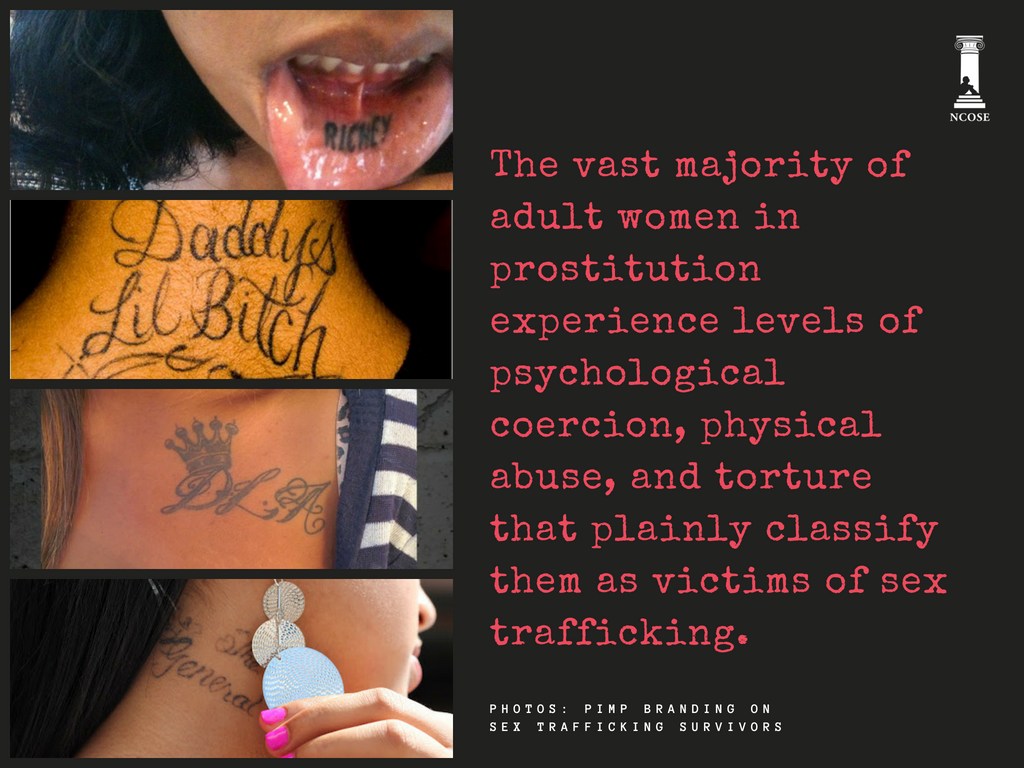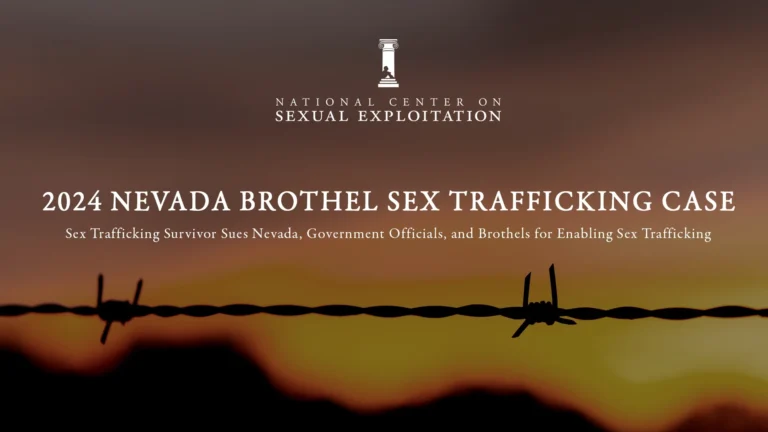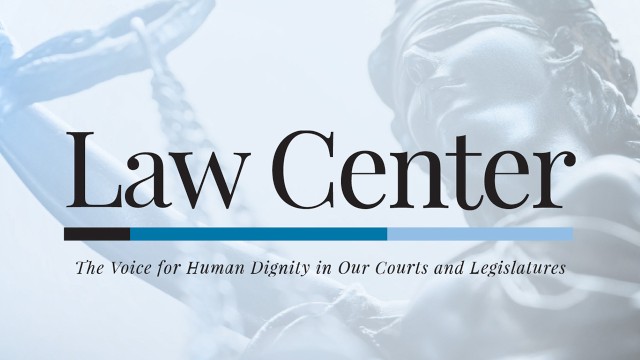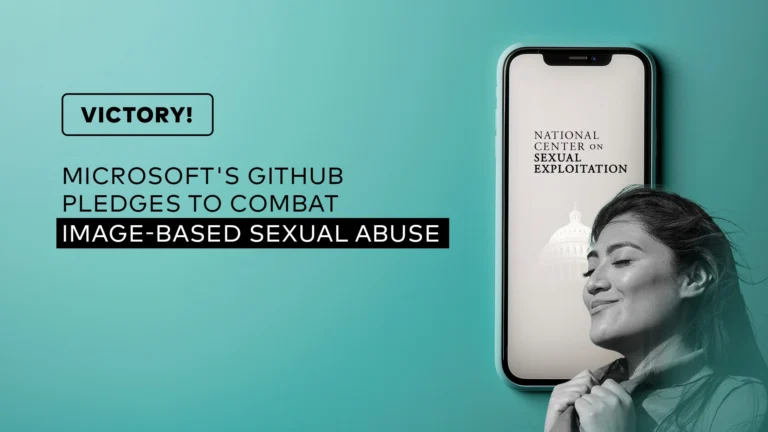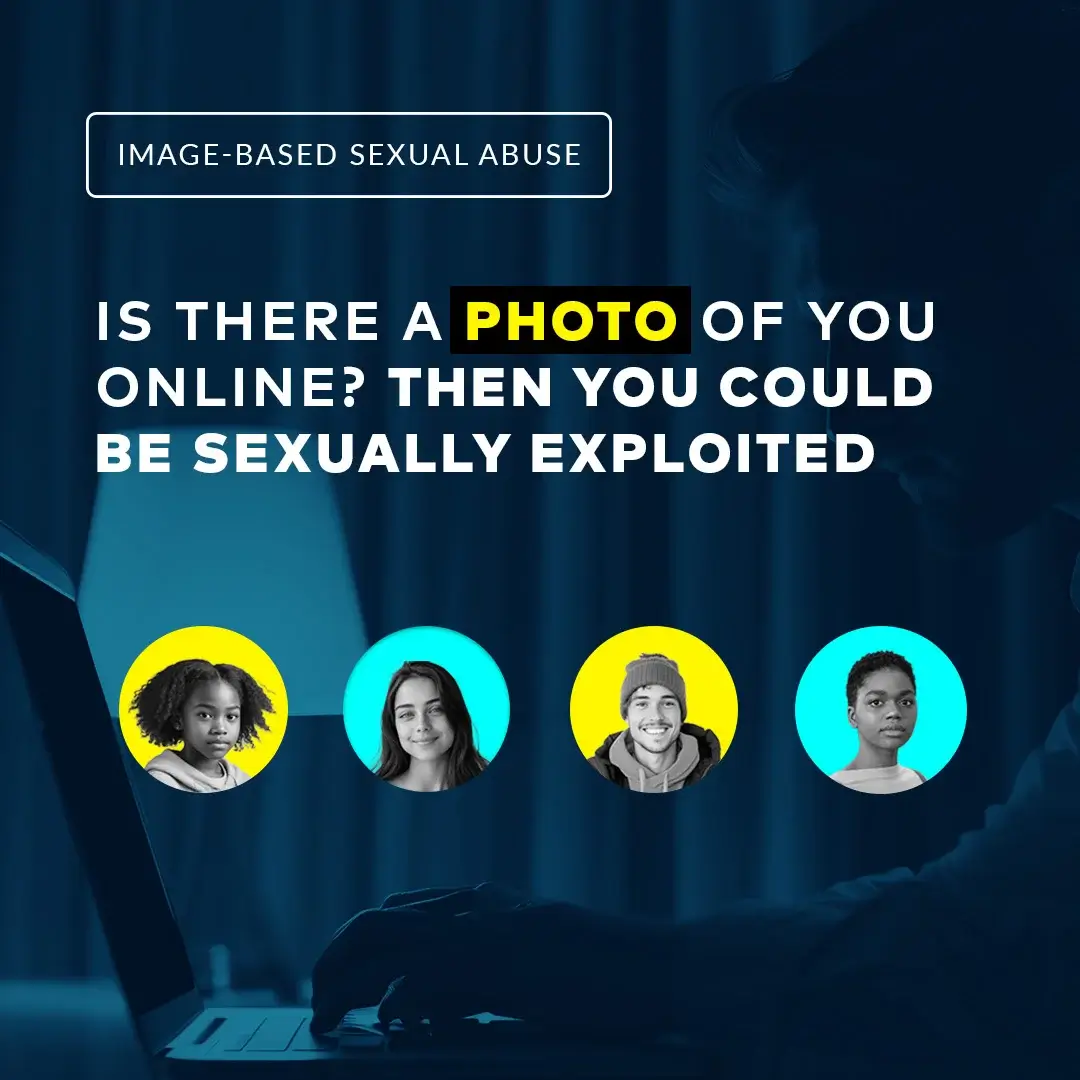
The Problem
Nevada is the only state in America with legalized brothel prostitution, in select counties. As of February 2018, there were at least 21 brothels active in Nevada.While some may claim that legalization provides better regulation and increased safety – the truth is that sexual violence, racism, and socioeconomic disadvantages are inextricable from the prostitution experience. The FBI reported that the District of Nevada closed out 2020 having filed more human trafficking cases than in any previous year.
Nevertheless, nearly 81% of the voters in Lyon County, Nevada voted to keep brothels legal in 2018. This made 81% of Lyon County citizens complicit in the sex trade, and therefore complicit in the sexual exploitation (and even sex trafficking) of countless women.
Survivor of sex trafficking, Rebekah Charleston, together with other survivors of sexual exploitation and violence have released a blistering video denouncing Nevada for legal prostitution—a legal framework which fuels sexual exploitation and violence. Rebekah Charleston and Angela Delgado-Williams also filed a pioneering lawsuit against the state of Nevada.
Research & FAQ's
The Problem with Legalized Prostitution
Even when it is legalized, it is impossible to disentangle exploitation from prostitution.
One woman who survived being prostituted in two legal brothels in Nevada stated:
“We did not have the “independent contractor” freedom to turn down buyers. Management required us to line up when someone arrived at the brothel. Once picked from the lineup, we would bring the sex buyer back to our room where he was allowed to do whatever he wanted with us… The violent-natured men I encountered in legal brothels are no different than the men buying sex on the streets. I cannot count the number of times I physically fought with men in the brothels and how many times I have been raped because I was too scared to fight back.”
Research confirms that the vast majority of those in prostitution (whether legalized, unregulated, or criminalized) experience both the constant threat of and high rates of, sexual violence and even Post-Traumatic Stress Disorder.
Legalized prostitution in Nevada has led to a massive sex industry in the state.
When compared to other states, Nevada’s sex trade (both legal and illegal) is at a minimum 63% higher than the next highest state of New York, and double that of Florida.
This proves the point that legalizing prostitution increases the demand for prostitution. When sex buying is decriminalized the demand for commercial sex skyrockets. This creates a great incentive for pimps and sex traffickers to push more people, especially women, into prostitution both within and outside of legal prostitution frameworks.
Further, a recent audit of Nevada legal brothels in Lyon County found that 30% of the women had red flags for being sex trafficking victims.
Instead of legalizing and embracing sexual exploitation, prostitution policies should work to combat demand (highly penalizing and reducing sex buyer behavior) and should offer social services and job training opportunities to the women engaged in prostitution to help them exit the industry.
Anyone involved in prostitution can find resources to aid them in exiting the sex trade at www.sextradesurvivorresources.com.
Research on Physical and Sexual Violence in Prostitution
DOWNLOAD RESEARCH COMPILATION – Prostitution: “The Zone” of Raw Male Physical and Sexual Violence
- Indicative of the violence inherent to prostitution, a manual providing health and safety tips for prostituting persons produced by the St. James Infirmary, a San Francisco based agency, instructs prostituting persons to:
- “Be aware of exits and avoid letting your customer block access to those exits.
- Be aware of where your client is at all times, as much as possible.
- Shoes should come off easily or be appropriate for running.
- Avoid necklaces, scarves, across-the-body shoulder bags or anything else that can be accidentally or intentionally tightened around your throat;
- Approach the driver’s window, keeping enough distance to avoid being grabbed, assaulted with spit or spray paint, or pleasing ‘window shoppers.’
- Study the customer, the car, and the door-lock system.
- Circle car completely before entering so you’re clear on how many passengers are in the car—and take the license plate number or pretend to. If you can, text-message all license plates to a safe person.
- Do not carry a weapon that can be taken away from you and used against you. If you are threatened or being attacked, use your voice. Make a lot of noise. Scream! Turn on the car lights. Hit the horn. Try to get the door open, attack and run. Attack soft areas, such as throat, eyes, Adam’s apple, nose, testicles. Kick shins, stamp on instep; poke with fingers, nails, keys, spray hairspray in his face. Do not let him restrain you; if you see rope, handcuffs or bindings, fight like hell!”[1]
- Semi-structured interviews of 47 prostituted women (aged 18-36) conducted in three Canadian provinces revealed violence or threats of violence from pimps, intimate partners, sex buyers, others in the sex trade, members of the public, institutional social service providers, and police. Investigators did not ask questions specific to abuse and violence—the information emerged in response to questions such as, “How did you become involved in prostitution.” Investigators report that the amount of violence and abuse that emerged was “startling.”
- 47% of the women reported that their intimate partners physically, sexually, verbally, and financially abused them;
- 23% were coerced into prostitution by boyfriends;
- 2% of these women also reported being assaulted, sexually assaulted, or propositioned by a police officer.
- More than 50% of the women reported experiencing violence from sexual buyers, including being: stabbed or cut, raped, gang-raped, raped at gunpoint, forced to engage in degrading sexual acts, choked/strangled, beaten, kidnapped, stalked, held with a gun to head, tied up, tortured, beaten with objects (e.g. baseball bat, crowbar), and run over.
- One woman stated, “I figure I probably should have been dead at least 10 times.”[2]
- In Karnataka, India, 3,852 females in prostitution participated in an integrated behavioral-biological assessment survey (IBBAs) in 4 different districts, and 7,638 prostituting females participated in 691 polling booth surveys (PBS). These surveys found that 11% of the prostituted females surveyed in the IBBAs and 26.4% in the PBS reported having been beaten or raped in the past year. Participants in the IBBAs reported that the main perpetrators of violence were: clients (56.2%), regular partners (22.8%), ‘rowdies’ (6.9%), the police (6.6%) and pimps (3.0%). Those who were raped were more likely to be younger, be non-local to the area, and have more than 10 clients per week. Higher rates of violence and rape were connected to non-condom use, as well as higher incidents of anal sex and gonorrhea infection.[3]
- A study of 222 prostituted women (aged 18-59) in Chicago, who were currently in prostitution or had been within the past five years, reported violence across seven common prostitution activities (escort, exotic dancing, prostitution from one’s own residence, street, hotels, drug house, and survival sex). Violence was reported by the women in all prostitution venues. The 12 most common forms of violence included: slapping; punching; hair pulling; pinching; spanking; kicking; ripping clothes; throwing something; threats with weapons; threats of rape; inserting fingers/objects; and rape.
- 80% of women in street prostitution had been threatened with a weapon at least once,
- 4% were rape; 55.4% were threatened with rape;
- 50% of women in escort prostitution had been raped, and 39.9% were threatened with either a weapon or rape;
- 21% of women engaging in prostitution in their residence had been raped 10 or more times;
- Sex buyers were responsible for 62-100% of violence against women in street-based prostitution;
- Sexual buyers were responsible for 30-100% of violence against women in exotic dancing;
- Perpetrators of violence were most commonly sex buyers, intimate partners, neighbors, and least commonly police.[4]
- Of the 43 prostituted women interviewed in the study, 72.1% reported severe abuse at the hands of pimps, male sexual buyers, or boyfriends. The acts of abuse include being: raped, beaten with objects, threatened with weapons, and abandoned in remote locations.[5]
- A comparative study of 46 formerly prostituted females (indoor prostitution only) and a control group (CG) of 31 age and education matched South Korean women found that of the prostituted women:
- 3% experienced serious economic crisis including homelessness/CG 9.7%;
- 6% were kept under surveillance or in captivity/CG 3.2%;
- 7% were threatened with harm against those close to her or herself/CG 9.7%;
- 2% had their daily activities such as eating, sleeping, and using toilets were controlled/CG 0%;
- 3% physical appearance, body weight, and clothing controlled/CG 0%;
- 6% experienced unexpected/ uncontrollable sexual/ physical attack/CG 6.5%;
- 3% were emotionally abuse, shamed, neglected, and spoken ill of/CG 3.2%.[6]
- In-depth interviews with 16 women (aged 20-38) incarcerated for prostitution-related offenses or on other charges but known to engage in prostitution, in a Midwestern county jail in the U.S., revealed that:
- 8% had experienced some sort of sexual assault;
- 75% had been raped by one or more sex buyer;
- 6% raped in another context on the streets;
- 5% had been kidnapped and held captive;
- 2% had been beaten;
- 3% punched or kicked;
- 3% stabbed or slashed;
- 25% hit with an object like a bat or brick
- 1 woman had been tortured with electric shock.
The authors observed that, “Once a prostitute has consented to any exchange of sex for money, these women see many men as assuming that she has given up the right to refuse consent in any situation. Once her sexuality has been ‘purchased,’ her body ‘belongs’ to the purchaser to use. This was the constant theme in the interviews. Many women encountered men who treated their agreement to engage in some form of sex as permission to abuse the women’s bodies in any way they wished, as long as they gave the women monetary compensation (p 11-12).”[7]
- An investigation into the morality rate of women in prostitution revealed that the leading cause of death was homicide (19%) and found that actively prostituting women were nearly 18 times more likely to be murdered that women of similar age and race during the study interval. The homicide rate for women in prostitution of 204 per 100,000, was many times higher than that for women and men in occupations with the highest workplace homicide rates in the U.S. in the 1980s: 4 per 100,000 for female liquor store worker and 29 per 100,000 for male taxi cab drivers.[8]
- In a Midwestern city in the U.S., 13 women (aged 18-40 years old) who were engaged in street prostitution participated in a survey on violence, risk, and survival strategies. Twelve (92.3%) of the women reported sex buyer-related violence. Violence was described as common, frequent, and pervasive.
- 3% slapped, punched, kicked, hit;
- 5% choked, beaten;
- 5% raped or repeated attempted rape;
- 5% assaulted and robbed;
- 4% tortured with perversion;*
- 8% pushed out of moving vehicle;
- 1% tied up against will;
- 1% beaten with blunt object;
- 4% kidnapped and held hostage;
- 4% stabbed repeatedly;
- 4% crashed through glass
- *Torture with perversion included being stuffed into a trunk, having a knife inserted into the vagina, being forced to sit on a gear shift anally, being burnt on the chest as a brand, and being severely bitten on the vagina and nipples.[9]
- A study of 854 individuals (women, girls, and transgendered people) currently or recently in prostitution in nine countries (Canada, Colombia, Germany, Mexico, South Africa, Thailand, Turkey, United States, and Zambia), investigated their lifetime history of sexual and physical violence. Some of those interviewed had been trafficked for the purpose of prostitution and were engaged in legal prostitution. Types and amount of violence experienced in prostitution are as follows:
- 71% physically assaulted;
- 57% raped; of those raped, 59% were raped more than 5 times;
- 64% threatened with a weapon;
- 88% verbal abuse;
- 49% had pornography made of them;
- 47% were upset by attempts to coerce them perform something a sex buyer had seen in pornography;
- In Germany, where prostitution is legal, 59% responded that prostitution is not safer with legalization;
- 89% wanted to exit prostitution.
- Equating prostitution with death, one woman stated, “Why commit suicide? I’ll work in prostitution instead (p. 53).”[10]
- One hundred street-based prostituted women and children were interviewed in Vancouver, B.C. regarding their experience of violence in prostitution. The study found that 52% of those interviewed were Canada’s First Nations (Native Indians) persons, whereas the general populace of Vancouver is only 1.7-7% First Nations. Respondents reported a history of prostituting in multiple venues, including: escort, massage, and street-level prostitution. Types and amounts of violence experienced while in prostitution included:
- 90% physically assaulted; 82% of assaults were perpetrated by sex buyers;
- 88% verbal abuse;
- 67% threatened with a weapon;
- 78% raped; of those raped, 67% were raped more than 5 times;
- Of those raped 76% were raped by sex buyers;
- 67% had pornography made of them while in prostitution;
- 64% upset by attempts to force them to perform something a sex buyer had seen in pornography;
- 95% wanted to exit prostitution;
- One woman reported: “What rape is to others, is normal to us (p. 254).”[11]
- Violence perpetrated by sex buyers within the last year was reported by 36% of 278 women (aged 18-49) surveyed in street-based prostitution in Miami. Forms of violence most commonly reported were being ripped off, beaten, threatened with a weapon, or raped by a sex buyer. The level of violence experienced within the past three months jumped to 71.2% when boyfriends, drug dealers, other street people, relatives, and police were included as perpetrators.[12]
- Of 294 prostituting women (aged 18 and above) interviewed in Miami, FL, it was reported that 75.5% had been victimized by someone during the previous 90 days (data not shown), and that 51.7% had experienced physical violence from sexual buyers in the last year.
Last 30 Days Last Year
- Cornered 1% 42.9%
- Ripped off 0% 32.0%
- Escaped from violent date 3% 28.2%
- Beaten 2% 25.5%
- Threatened with a weapon 6.1% 6%
- Raped/gang-raped 4% 13.9%
- Shot at/cut 1% 7.5%
- Victimized by any means 6% 51.7%[13]
- Sixty-seven percent of 57 women involved in street prostitution in Chennai, India, reported experiencing one or more episode of violence, including being hit, kicked, burned, raped, gang raped, and involuntarily restrained while prostituting. These acts were perpetrated by sexual buyers, pimps, madams, and police. Ninety-five percent of the women reported neglect by their husband, lack of support from husband, death of a husband, violence by husband, or alcohol- or drug-addicted husband.[14]
- A study of 106 women involved in street-based prostitution conducted in New York City reported types and amounts of violence experience while in prostitution included:
- Abuse by intimate partner (45) Lifetime In the past year
- Physical abuse 8% 20.0%
- Sexual abuse 2% 8.9%
- Physical and sexual abuse 3% 22.2%
- Abuse by sexual buyers (106)
- Physical abuse 3% 23.6%
- Sexual abuse 9% 20.8%
- Physical and sexual abuse 0% 32.1%[15]
- A study in San Francisco interviewed 130 prostituting persons (women, men, and transgender men, aged 14-61) regarding violence in their lives and symptoms of posttraumatic stress disorder (PTSD). Types and amounts of violence experienced while in prostitution included:
- 82% physically assaulted; 55% of physical assaults were perpetrated by sex buyers;
- 80% of physical attacks by pimps and sex buyers resulted in serious injuries;
- 83% threatened with a weapon;
- 68% were raped; 48% were raped 5 or more times;
- Of those raped, 46% were raped by sex buyers;
- 49% had pornography made of them while in prostitution;
- 32% were upset by attempts to make them act out pornography;
- 88% wanted to leave prostitution.[16]
- Of 303 prostituted females (aged 15 and above) interviewed in New Zealand, 58% reported that they felt pressure to accept a client when they did not want to (53% street-based; 59% indoor-based). Females in street-based prostituted refused sex buyers more often than indoor-based women (85% compared to 55%). One or more violent events were reported by 83% of those surveyed. Types and amounts of violence included:
- Street-based:
- 54% – refusal to pay (after provision of sex act)
- 42% – money stolen by sex buyer
- 41% – physically assaulted
- 65% – threatened with physical violence
- 23% – held somewhere against their will
- 82% – verbal abuse
- 27% – raped
- 21% – forced to have unprotected sex
- Indoor-based:
- 46% – refusal to pay (after provision of sex act)
- 25% – money stolen by sex buyer
- 21% – physically assaulted
- 26% – threatened with physical violence
- 13% – held somewhere against their will
- 52% – verbal abuse
- 8% – raped
- 9% – forced to have unprotected sex.[17]
- A comparative study of prostituting females from three U.K. cities reported that the violence ratio between outdoor and indoor prostitution was 81% to 48%. Fifty percent of street prostituted women and 26% of indoor prostituted women reported violence by clients in the last six months, and only 34% of women reported violence to the police (44% of street and 18% of indoor prostituted women).
- Outdoor:
- 47% slapped, kicked or punched;
- 39% threatened with physical violence;
- 37% robbed;
- 27% beaten;
- 24% threatened with weapon;
- 25% held against their will;
- 20% strangulation;
- 20% kidnapped;
- 28% attempted rape;
- 22% raped vaginally;
- 5% raped anally.
- Indoor prostitution:
- 14% slapped, kicked or punched;
- 14 % threatened with physical violence;
- 10% were robbed;
- 1% were beaten;
- 8% threatened with weapon;
- 15% held against their will;
- 6% strangulation;
- 2% kidnapped;
- 17% attempted rape;
- 2% raped vaginally;
- 6% raped anally.[18]
- Women and children can be controlled in indoor prostitution in ways they cannot on the street. Indoor prostituted women can be locked in their rooms, heavily drugged, restrained, beaten, and remain invisible trafficking victims.[19]
- Of 200 prostituting women in Tamil Nadu, India, more than 95% reported experiences of violence. The forms of violence experienced include beatings, acid attacks, stabbing or cutting with knives, breaking arms or legs, sexual harassment, rape, hitting with hard objects, throwing stones, shaving heads, putting chili powder in the eyes, beating the soles of feet and then forcing them to jump up and down, and murder.[20]
- A study of 325 actively prostituting females, in Miami, Florida, reported types and amounts of violence in prostitution in the last 12 months that included:
- 5% violent sex buyer;
- 9% robbed;
- 9% beaten;
- 8% threatened with a weapon;
- 9% raped;
- Drug-using women in street prostitution experienced 43 times higher rates of rape and 13 times higher rates of physical assault than the national average of women.[21]
- A study of 72 females involved in street-based prostitution in Sydney, Australia, found that violence while prostituting was experienced by 85% of the women, and only 35% of these incidents were reported to the police. The types and amounts of violence included:
- 65% physical assault;
- 40% were rape at gun/knife point;
- 33% were raped without a weapon;
- 44% were raped in their personal lives;
- 29% robbed;
- 21% attempted rape;
- 13% were threatened/attacked with a weapon;
- 71% witnessed serious injury to or death of another person (while in prostitution or in personal lives).[22]
- In a comparative study sex buyers were more likely than non sex buyers to express a preference for impersonal sex, had greater hostile masculinity, greater self-reported likelihood of raping, and a greater history of sexual aggression.[23]
- 54% of murders of women in prostitution were perpetrated by strangers (54%), compared to only 6.8% of female, nonsexual murder victims.[24]
- In Antwerp, Belgium, a brothel operator installed biometric scanners in his state-of-the-art 51-roomed brothel; the scanners insure that only legally registered prostituting women use the rooms. Each room is also equipped with a panic button next to the bed, which when pushed calls police and sets off a red flashing light in the brothel’s control room. Ironically this brought comfort to one prostituted woman who said, “In the old days I worked in a place where you were lucky if the electricity worked and I feared for my life . . . . If something should happen to me and I turn up dead tomorrow—the technology here means that police will know exactly who I am.”[25]
- Among a study of 32 formerly prostituted women (aged 19-45) interviewed for a study in Vancouver, British Columbia, some reported violence in massage parlors in which the sexual buyers would assault them and the owners told them to endure it. Some reported abuse from the owners themselves, including being pushed down a flight of stairs
The same study found that in pimp-controlled prostitution, that pimps beat “their” women regularly, often without any precipitating factors, to show them who was in control and to inculcate fear of attempting to exit the trade. Some beatings involved utilization of a pimp stick—a coat hanger that has been unraveled and doubled over; occasionally the pimp stick is heated on a stove to increase the degree of pain. One interviewee reported being unable to look at wire coat hangers and having to stock her house only with plastic hangers, even years after exiting the industry.[26]
- Two hundred females formerly and currently involved in street prostitution in the San Francisco area, 73% reported 193 cases of rape. Allusions to pornographic material on the part of the rapist were made in 24% of the cases of rape reported. Respondents provided this information without any solicitation from or reference to pornography on the part of the interviewer. The consistent pattern that emerged revealed that assailants referred to pornographic materials he had seen or read and then insisted that the victims not only enjoyed the rape but also the extreme violence.[27]
- A study conducted of 50 women (aged 19-46) incarcerated for prostitution in a large, northeastern American city found that:
- 58% were verbally abused by a sex buyer;
- 36% were hit;
- 30% were robbed or had a weapon used against them;
- 32% have had a sex buyer attempt to rape them;
- 26% were raped;
- 53% were regularly beaten by pimps.
- One woman continued to prostitute despite a knife wound from a deranged street person. Her next sex buyer was concerned, not with the fact that she was injured, but with the possibility that her bleeding would damage his upholstery.
- The women unanimously stated that they would not recommend street prostitution to other women. [28]
- A study of 1000 prostituting females (aged 16-40), found that younger females were more likely to report rape (8.2%) within the last month, compared to 3% of older prostitution females.[29]
- A Canadian commission found that the death rate of women in prostitution due to violence and drug overdose may be 40 times higher than that of the general public.[30]
- Interviews of 100 individuals (females (42%), males (32%), and transgender males (26%)) involved in street-based prostitution in inner city Washington, D.C., found high incidents of violence. Since entering prostitution, 61% reported being physically assaulted, with the majority being perpetrated by sexual buyers (75%). The violence in prostitution was reported as follows:
Female Male Transgender Sample
n=42 n=32 n=26 n=100
Physically assaulted 85.7% 28.1% 65.4% 61.0%
Customer 80.6% 62.5% 70.6% 75.4%
Someone Else 13.9% 37.5% 29.4% 21.3%
Pimp 5.6% 0.0% 0.0% 3.3%
Threatened 90.5% 84.4% 88.0% 87.9%
Threatened with a weapon 73.8% 78.1% 88.0% 78.8%
Raped in prostitution 73.8% 12.5% 34.6% 44.0%
Times rape in prostitution
Once 22.6% 75.0% 66.7% 36.4%
2-5 61.3% 25.0% 22.2% 50.0%
6-10 6.5% 0.0% 11.1% 6.8%
11-19 3.2% 0.0% 0.0% 2.3%
Over 20 6.5% 0.0% 0.0% 4.5%
Who raped you?
Customer 71.9% 0.0% 60.0% 60.0%
Someone Else 34.3% 100.0% 40.0% 58.0%
Pimp 3.1% 0.0% 20.0% 4.0%
Upset when asked to do
something seen in a 26.2% 53.1% 30.8% 36.0%
pornographic video
Hurt with words 52.4% 37.5% 57.7% 49.0%
Safer if prostitution legal 42.9% 62.5% 50.0% 50.0%
Wanted to exit prostitution 67% 91.0% 73.0% 76.2%[31]
- The 31 females (77%) and transvestites (23%) in prostitution (street-based (80%) and indoor (20%)) in Belgrade and Pancevo, Serbia, reported using a sex buyers sorting strategy to reduce risk to avoid the “messy,” “dirty,” and “dangerous,” in favor of the “married,” “normal,” and “clean.” All individuals reported experiencing violence linked to their prostitution involvement. One prostituting transvestite stated, “I find it very difficult to get into someone’s car . . . because life is at stake.”[32]
- Women in prostitution are a target group for serial offenders, such as:
- Arthur Shawcross (New York), “Genesee River Killer,” who between 1988 and 1990 killed 11 women in prostitution;
- William Lester Suff (California), “Riverside Prostitute Killer,” was convicted of 12 murders of women in prostitution and was suspected of committing 10 others (Mendoza, 2002);
- Saeed Hanaei (Iran), confessed to strangling 16 of the 19 prostituting women who had been murdered in Mashad in 2001;
- Gary Ridgway (Washington) the “Green River Killer” pleaded guilty to the murders of 48 women from 1982 to 1998, most of whom were involved in prostitution.[33]
- Robert Pickton, convicted of murdering 6 women (20 additional counts were stayed) and who is suspected of murdering more than 30 women.[34] Most of his victims were involved in prostitution.[35]
- A study of 18 women involved in stripping in the Midwestern U.S. found that male sex buyers, managers, staff and owners used diverse methods of harassment, manipulation, exploitation, and abuse to control the women. Types and amounts of abuse experienced by the women included:
- 100% physical abuse on an average of 7.7 times;
- 100% sexual abuse on an average of 4.4 times;
- 100% verbal abuse on an average of 4.8 times;
- 100% propositioned for prostitution (78% propositioned every day);
- 78% stalked by a person associated with the club;
- 61% attempted sexual assault by a person associated with the club;
- 100% of the women witnessed violence in the club, of which it was reported that there were no consequences for the male perpetrators.
The abuses suffered by the women, included:
- Grabbed by breasts, buttocks, and genitals;
- Licked and pinched;
- Costume pulled off;
- Coins thrown at her;
- Garbage thrown at her;
- Men exposing their penises;
- Men masturbating in front of;
- Penetrated vaginally and anally with fingers and objects;
- Forced to masturbate a man;
- Rape;
- Followed to her car;
- Followed home;
- Followed in her private time;
- Sent letters, given gifts, and called against their wishes;
- Sexually abused and exploited by owners as a condition of work
- Called cunt, slut, whore, pussy, bitch, and more. [36]
- Thirty-five women (aged 23-41) involved street prostitution participated in a study conducted in inner city Hartford, Connecticut. Researchers found that:
- 90% experienced violence from sex buyers;
- 60% had been raped while in prostitution;
- 75% reported physical abuse by husbands and boyfriends;
- 7% were victims of incidents in which they were nearly killed by sex buyers;
- 25% had friends who were murdered while in prostitution;
- The women witnessed daily occurrences of violence directly related to the protection of drug territories, settlement of drugs debts, and concurrent violence that influenced their lives.
- One woman stated, “I don’t want to have to go out and keep selling my body like this anymore. It’s degrading. . .I’m afraid If I keep doing this that I’m going to get to a point so low that I won’t want to bring myself back. . .It’s very degrading, it makes you feel like you’re nothing.”[37]
- S. Army Field Manual No. 2-22.3 expressly bans U.S. military personnel from perpetrating acts of torture including forcing an individual to perform or simulate sexual acts or to pose in a sexual manner, as well as exposing an individual to outrageously lewd and sexually provocative behavior in any context. It also prohibits forcing the detainee to be naked, perform sexual acts, or pose in a sexual manner in interrogations. Any single act of such sexual abuse is a violation of the code. Yet, such acts—serially committed—are the quintessence of what pimps do. Thus, in respect to the sexual abuse that they perpetrate or orchestrate on behalf of sex buyers all pimps can be said to be torturers.[38]
- “At the 15th International AIDS conference in Bangkok (July 2004), several sex worker groups presented information about the occupational health and safety of prostitutes. Members of Bangkok organization EMPOWER instructed women in bar prostitution (one type of indoor prostitution) how to insert and pull out razor blades from their vaginas. This is understood to be a job requirement in the bar-show setting where tricks are sexually exited by the possibility of genital mutilation of Thai women.”[39]
- A sex-shop owner who also rented rooms to prostituting women in Amsterdam, lamented the government’s requirement of a pillow in rooms where sex is sold saying, “You don’t want a pillow in your room. It’s a murder weapon.”[40]
- A woman in prostitution woman stated, “You just give them what they want and pray they don’t kill you.”[41]
- The perception of persons in prostitution as disposable people was captured in this statement from a sex buyer, “For me, being with a prostitute is not a relationship. It’s like having a cup of coffee, when you’re done, you throw it out.”[42]
[1]Akers, N. & Evans. C. (2004). Occupational health and safety handbook (3rd ed.). St. James Infirmary.
[2] Nixon, K., Tutty, L., Downe, P., Gorkoff, K., & Ursel, J. (2002, September). The everyday occurrence: Violence in the lives of girls exploited through prostitution. Violence Against Women, 8(9), 1016-1043.
[3] Beattie, T., Bharracharjee, P., Ramesh, BM., Gurnani, V., Anthony, J., Isac, S., et al. (2010). Violence against female sex workers in Karnataka state, south India: Impact on health, and reductions in violence following an intervention program. BMC Public Health, 10(476).
[4] Raphael, J. and Shapiro, D. (2002, August). Sisters speak out: The lives and needs of prostituted women in
Chicago. Center for Impact Research, 1-35.
[5] Dalla, R. (2000, November). Exposing the “pretty woman” myth: A qualitative examination of the lives of female streetwalking prostitutes. The Journal of Sex Research, 37(4), 344-353.
[6] Choi, H., Klein, C., Shin, M. & Lee, H. (2009, August). Posttraumatic stress disorder (PTSD) and disorders of extreme stress (DESNOS) symptoms following prostitution and childhood abuse. (2009). Violence Against Women, 15(8), 933-951.
[7] Miller, J., & Schwartz, M. (1995). Rape myths and violence against street prostitutes. Deviant Behavior: An Interdisciplinary Journal, 16(1), 1-23.
[8] Potterat, J., Brewer, D., Muth, S., Rothenberg, R., Woodhouse, D., Muth, J. et al. (2004). Mortality in a long-term open cohort of prostitute women. American Journal of Epidemiology, 159(8), 778-785.
[9] Williamson, C. & Folaron, G. (2001). Violence, risk, and survival strategies of street prostitution.
Western Journal of Nursing Research, 23(5), 463-475.
[10] Farley, M., Cotton, A. et al. (2003). Prostitution and Trafficking in Nine Countries: An Update on
Violence and Posttraumatic Stress Disorder. Journal of Trauma Practice, 2(3/4), 33-74.
[11] Farley, M., Lynne, J. and Cotton, A. (2005). Prostitution in Vancouver: Violence and the colonization of First Nations women. Transcultural Psychiatry, 42(2), 242-271.
[12] Surratt, H., Kurtz, S., Weaver, J. & Inciardi, J. (2005). The Connections of Mental Health Problems, Violent Life
Experiences, and the Social Milieu of the “Stroll” with the HIV Risk Behaviors of Female Street Sex Workers. Contemporary Research on Sex Work, 23-44.
[13] Kurtz., S., Surratt, H., Inciardi, J., & Kiley, M. (2004, April). Sex work and “date” violence. Violence Against Women, 10(4), 357-385.
[14] Suresh, G., Furr, L., & Srikrishnan, Aylur, et al. (2009). An assessment of the mental health of street-based sex workers in Chennai, India. Journal of Contemporary Criminal Justice, 25(2), 186-201.
[15] El-Bassel, N., Witte, S., Wada, T., Gilbert, L. & Wallace, J. (2001). Correlates of partner violence among female street-based sex workers: Substance abuse, history of childhood abuse, and HIV risks. AIDS Patient Care and STDs, 15(1), 41-51.
[16] Farley, M. and Barkan, H. (1998). Prostitution, Violence Against Women, and Posttraumatic Stress
Disorder. Women & Health, 27(3), 37-49.
[17] Plumridge, L., & Abel, G. (2001, February). A ‘segmented’ sex industry in New Zealand: Sexual and personal safety of female sex workers. Australian and New Zealand Journal of Public Health, 25(1), 78-83.
[18] Church, S., Henderson, M., Barnard, M., & Hart, G. (2001). Violence by clients towards female prostitutes in different work settings: questionnaire survey. British Medical Journal, 322(7285), 524-525.
[19] Farley, M. (2005). Prostitution harms women even if indoors: Reply to Weitzer. Violence Against Women, 11(7), 950-964.
[20] Jayasree, AK. (2004). Searching for justice for body and self in a coercive environment: Sex work in Kerala, India. Reproductive Health Matters, 12(23), 58-67.
[21] Surratt, H., Inciardi, J., Kurtz, S., & Kiley, M. (2004, January). Sex work and drug use in a subculture of violence. Crime & delinquency, 50(1), 43-59.
[22] Roxburgh, A., Degenhardt, L. & Copeland, J. (2006, May). Posttraumatic stress disorder among female
street-based sex workers in the greater Sydney area, Australia. BMC Psychiatry, 6(24), 1-12.
[23] Farley, M., Golding, J., Matthews, E., Malamuth, N., & Jarrett, L. (2015, August). Comparing sex buyers with men who do not buy sex: New data on prostitution and trafficking. Journal of Interpersonal Violence.
[24] Salfati, C. G., James, A., and Ferguson, L. (2008). Prostitute Homicides: A Descriptive Study. Journal of Interpersonal Violence, 23(4), 505-543.
[25] Bilefsky, D. (2005, May 26). Belgian experiment: Make prostitution legal to fight its ills. The Wall Street Journal, p. A1.
[26] Kennedy, M., Klein, C., Bristowe, J., Cooper, B., & Yuille, J. (2007). Routes of recruitment: Pimp’s techniques and other circumstances that lead to street prostitution. Journal of Aggression, Maltreatment & Trauma, 15(2), 1-19.
[27] Silbert, M., & Pines, A. (1984). Pornography and sexual abuse of women. Sex Roles, 10(11/12), 857-868.
[28] Norton-Hawk, M.A. (2001) The Counter-productivity of Incarcerating Female Street Prostitutes. Deviant Behavior: An Interdisciplinary Journal, 22, 403-417.
[29] Pettifor, A., Turner, A., Van Damme, K., Hatzell-Hoke, T., Rasamindrakotroka, A., et al. (2007). Increased Risk of Chlamydial and Gonococcal Infection in Adolescent Sex Workers in Madagascar. Sexually Transmitted Diseases, 34(7), 475-478.
[30] Special Committee on Pornography and Prostitution. (1985). Pornography and prostitution in Canada, (Vol. 2), 350.
[31] Valera, R., Sawyer, R. & Schiraldi, G. (2001). Perceived Health Needs of Inner-City Street
Prostitutes: A Preliminary Study. American Journal Health Behavior, 25(1), 50-59.
[32] Rhodes, T., Simic, M., Baros, S., Platt, L., & Zikic, B. (2008). Police violence and sexual risk among female and transvestite sex workers in Serbia: Qualitative study. BMJ, 337, 1-8.
[33] Salfati, C., James, A., & Ferguson, L. (2008). Prostitute homicides: A descriptive study. Journal of Interpersonal Violence, 23(4), 505-543.
[34] MacQueen, K. (2010, August 13). How serial killer Robert Pickton slipped away. New revelations show why he was able to prey with such impunity. MacLean’s. Retrieved September 28, 2015, from http://www.macleans.ca/news/canada/how-a-serial-killer-slipped-away/.
[35] Farmer ‘skinned victim on meat hook.’ (2007, Jan 26). The Guardian. Retrieved September 28, 2015, from http://www.theguardian.com/world/2007/jan/26/1
[36] Holsopple, K. (1997). Strip club testimony. The Freedom and Justice Center for Prostitution Resources: A Program of the Volunteers of America of Minnesota, 1-17.
[37]Romero-Daza, N., Weeks, M., & Singer, M. (2003). “Nobody gives a damn if I live or die”: Violence, drugs, and street-level prostitution in inner-city Hartford, Connecticut. Medical Anthropology, 22, 233-259.
[38] Thompson, L. (2011). On a street corner near you: Pimps as practioners of torture. In R. Dalla, L. Baker, J. DeFrain, & C. Williamson (Eds.), Global Perspectives on Prostitution and Sex Trafficking. Europe, Latin America, North America, and Global (pp.291-313). Plymouth, UK: Lexington Books.
[39] Farley, M. (2005, July). Prostitution harms women even if indoors: Reply to Weitzer. Violence Against Women, 11(7), 950-964.
[40] Daley, S. (2001, August 21). New rights for Dutch prostitutes, but no gain. The New York Times. Retrieved January 11, 2009, from Lexis Nexus.
[41] Dalla, R., Xia, Y., & Kennedy, H. (2003, November). “You just give them what they want and pray they don’t kill you.” Street-level sex workers’ reports of victimization, personal resources, and coping strategies. Violence Against Women, 9 (11), 1367-1394.
[42] Farley, M., Golding, J., Matthews, E., Malamuth, N., & Jarrett, L. (2015, August). Comparing sex buyers with men who do not buy sex: New data on prostitution and trafficking. Journal of Interpersonal Violence.
[43] Farley, M., Golding, J., Matthews, E., Malamuth, N., & Jarrett, L. (2015, August). Comparing sex buyers with men who do not buy sex: New data on prostitution and trafficking. Journal of Interpersonal Violence.
What is decriminalized prostitution? Is it different from legalized prostitution?
Decriminalized prostitution refers to the removal of laws criminalizing the sex trade. One form of decriminalization—commonly referred to as the Nordic model—targets only individuals involved in the selling of sex (i.e. prostituting persons); other forms of decriminalization may seek to decriminalize all parties involved in the provisioning, buying, and selling of sex. Thus, “full” decriminalization refers to the repeal of laws pertaining to pimping, brothel keeping, and sex buyers, as well as those who sell sex.
Legalized prostitution is generally understood to be regulated prostitution, although the term may also be used to refer to jurisdictions where there is no law explicitly prohibiting prostitution. Under systems of legalized prostitution, various regulations governing how commercial sex transaction are to be conducted are instituted. Such regulations may include brothel licensing requirements and restrictions on where brothels can locate, as well as establish requirements that prostituting persons officially register with the government, undergo compulsory health checks, and pay taxes on proceeds from prostitution.
A third approach to prostitution is known as prohibition. According to this approach all prostitution is viewed as criminal activity and all activities connected with prostitution (i.e. soliciting, procuring, pimping, brothel keeping) are criminalized.
What’s the problem with decriminalization of prostitution?
Across the United States, political efforts to normalize the commercial sex industry are popping up, often claiming to protect people in prostitution.
However, the reality is: There are no independent studies that show normalizing the sex trade by decriminalizing it or legalizing it makes it safer.
On the contrary, where prostitution is legalized/legitimized there’s an increase in sex trafficking, as demonstrated by an academic study of 150 countries led by the London School of Economics.
Why? For several logical reasons:
- Once you normalize the sex trade, it explodes.
In Germany, where prostitution and brothels have been legal since 2002, an estimated one million men buy sex each day, coming from all over the world.
The capital city, Berlin, alone has over 500 brothels.
- Men who don’t buy sex when it is illegal, become new clients.
As a 2018 study of 8,000 U.S. men demonstrates, over 20% of respondents who never bought sex, would consider engaging in exploitation if it was decriminalized or legalized.
- To satisfy demand, the sex trade has to lure in vulnerable people, because there are never enough women willing to be exploited and degraded in prostitution
Sex trafficking cases increased 70% in Germany as a result of legalization.
In The Netherlands were prostitution was legalized in 2000, an estimated 50-90% of women are selling their bodies against their will.
The illegal sex trade increases alongside the legal sector, when it is normalized.
Nevada, the only U.S. jurisdiction with legal brothels, has the highest rates of an illegal sex trade—63% higher than the next highest state of New York and double that of Florida.
Prostitution is inherently dangerous and harmful. The only way to protect people is to shrink the market.
A 2018 study of prostituted women, including trans women, in the U.S. found 61% suffered Traumatic Brain Injuries while in “the Life.”
In a nine-country study of 785 prostituted women, 68% suffered PTSD at same severity as combat veterans and victims of state torture.
The mortality rate of women in prostitution is 200 times the rate of the general population, according to a Colorado medical study examining two decades of evidence.
In an academic survey of women, including trans women, in DC engaged in street prostitution, 42% met the criteria for PTSD, 61% percent reported being physically assaulted, nearly 80% reported being threatened with a weapon, and 44% had been raped in prostitution, with 60% of these rapes committed by sex buyers.
What happened in areas where prostitution has been decriminalized or legalized?
A 2013 study of 150 countries from the London School of Economics found that wherever prostitution was legal, sex-trafficking tended to increase, not decrease.
Further, the state of Nevada (the only state in the U.S. with legalized prostitution in select counties) has the highest rates of an illegal sex trade in the country, adjusted for population. It is 63% higher than the next highest state of New York and double that of California.
Why? Because once something is legal, there is an increased demand for it.
And because prostitution is inherently dangerous and harmful, there are not many women or men who enter into it “willingly.” This means that sex traffickers push victims into the sex trade through force, fraud, or coercion in order to make a profit off of the high demand for commercial sex.
It is essentially impossible for sex buyers to vet and know if the person they are purchasing for sex is a sex trafficking victim or not. Most sex trafficking victims are not held in dungeons with literal chains but are instead imprisoned through psychological coercion and threats, so that they can meet sex buyers at various locations.
What's the problem with prostitution as long as it’s freely chosen?
The debate about choice in prostitution is always focused on those with the least power and control in the whole equation: the prostituting person. It’s time to discuss the choices of those with the real power—sex buyers, pimps, corporate interests, and governments—and hold them accountable for their choices to promote and participate in sexploitation.
If for nothing else, America is known for the bonanza of choices it presents to those living within its borders, and the freedom it extends to those individuals to pursue them. From the trivial, like what kind of milk (i.e. skim, 1%, 2%, whole, dairy, almond, soy, and a wide assortment of blends) and coffee we drink (ice mocha latte with a shot of espresso, anyone?), to the serious, like the occupations we pursue and those we elect—and everything in between—America affords its residents a cornucopia of choices. Indeed, choice and freedom are viewed by many as part of the American birthright.
In this context, supreme value is placed on the ability to choose, but not on what is chosen. As long as a perception of the freedom to choose exists, most people are happy to let others pursue whatever course they will. However, this “it’s your choice” approach to life, is not without its downsides. Just ask any recently divorced person who was traded in for someone younger and hotter how they feel about their ex-spouse’s choice to move on. Or consider the lives being lost because of the new wingsuiting craze that has motivated people to jump off mountains to experience “flying” but who tragically plummeted to their deaths. Clearly, then, not all choices are created equal.
This is especially true of prostitution. But, ask anyone involved in advocacy efforts or providing social services on behalf of prostituted persons, and they will tell you about the all-too-familiar, pro-prostitution, trump card otherwise known as “the choice argument.” It usually goes down like this: whenever a debate about prostitution arises, pro-prostitution advocates play their “choice card” by raising an argument which asserts that as long as prostitution is chosen, it no longer constitutes exploitation. Any harms that result are just the cost of poor decision making and the full responsibility of the person making the choice. The intended result is to shut down any arguments about the harms, the violence, the inequality, and dehumanization that are all part and parcel of prostitution. After all, to be anti-choice is to be anti-freedom, a proponent of oppression, and an unreasonable puritan, right? Without doubt it’s been a powerful tactic, but let’s examine the claim more carefully.
According to this view, no matter how injurious, dangerous, or pernicious the choice to prostitute may be, we must simply sit back and accept prostitution as a fact of life—as long as it is chosen. But as author and women’s advocate Rebecca Whisnant explains, “That something is chosen or consensual is perfectly consistent with its being seriously oppressive, abusive, and harmful—to oneself and/or to a broader group of which one is a member (e.g. women).” We wholeheartedly agree.
There are lots of choices one can make: to jaywalk, eat foods loaded with trans fat, drive above the speed limit, not wear a helmet while riding a motorbike, smoke, handle a loaded gun, or go wingsuiting in the Alps and many more. But as a civilized society we recognize that choices such as those listed above are potentially harmful to the individuals who engage in them, as well as others around them who don’t. In light of these dangers, society attempts to make rules, restrictions, and barriers on such activities, and in some cases even bans them. Why should it be any different for an activity as imbued with as much risk as prostitution?
To the extent that prostitution is ever truly a choice (for most of the people in it, it most decidedly is not), it’s a choice fraught with danger, and not just run-of-the-mill office place dangers (like slipping on wet floors), but physical and sexual violence that includes things like stabbings, rape, gang-rape, degrading sexual acts, choking/strangulation, beatings with fists or hard objects, kidnap, stalking, threat with a firearm, and torture—to mention a few. (For more on the physical and sexual violence native to prostitution, see our booklet Prostitution: “The Zone” of Raw Male Physical and Sexual Violence.)
Given this degree of potential harm, prostitution hardly seems like a choice that any caring society would sanction. But that’s exactly what happens when governments legalize or decriminalize prostitution—they choose to allow the vulnerable, the desperate, and the reckless to become the prey of the greedy, powerful, selfish, and lascivious. They choose to ensure that a pool of persons are always on supply as public, sexual property, disregarding the many lives that are offered up and the cost to individual bodies, minds, and spirits.
Ironically, the debate about choice in prostitution is always focused on those with the least power and control in the whole equation: the prostituting person. Those with the real power—sex buyers, pimps, corporate interests, and governments—are rarely, if ever, held accountable for their choices. Indeed, if sex buyers stopped choosing to buy sex today, the entire sex industry would disintegrate tomorrow.
Of course, no one is holding their breath waiting for that to happen. However, those who care about people in the sex trade can choose not to build a super highway to sexploitation by fully decriminalizing or legalizing prostitution, but to shrink the opportunities for pimps and sex buyers to operate by creating and enforcing tough penalties on their activities, and fostering pathways out of prostitution for those already in it. That’s the only choice that fosters dignity, wholeness, life and true freedom.
Isn't prostitution just another form of work?
Argument #1: Prostitution is sex work.
Response: “Sexual exploitation is nobody’s ‘job.’”
Several years ago the advocacy group Women Hurt in Systems of Prostitution (WHISPER) developed a powerful tool that communicated the extent of the harms experienced by persons in prostitution. Just what was this tool? Answer: a “job” description.
Few things undermine the myth of “sex work” like a detailed list of exactly what people caught up in the sex trade are expected to do¾night after night, day after day, month after month, year after long, miserable, interminable year. For those readers of stout mind and heart, you can read that “job” description here. However, for those who are triggered by depictions of sexual abuse and violence, do yourself a favor and skip the link. We’ll try to convey WHISPER’s message more delicately in what follows, but understand that there is nothingdelicate or tender about the sex of prostitution.
One of the main points at the heart of the debate about the full decriminalization of prostitution (by this we mean the removal of all laws and any regulations around prostitution, the removal of which infer a right for persons to barter and trade other persons for sexual consumption in brothels, strip and night clubs, street corners) is what one believes about work.
While there are several meanings ascribed to the term, for the purpose of this discussion work should be understood as the labor, task, or duty that is one’s means of livelihood. For most people work is a necessary part of ensuring one’s survival: we work as the means to earn our wages and to sustain ourselves and those we love. For some, work may be a drudgery, a toil to be endured; for others, it may be a passion—a lifelong pursuit of one’s deepest interests and aspirations. From banking, engineering, janitorial service, the insurance industry, food service, education, medical professions, agriculture, journalism, law enforcement, aviation, to horticulture and beyond, there are a myriad of occupations in which one may work.
But this work is typically pursued within parameters. As a society we recognize that work should be performed within certain boundaries, and thus create rules concerning how it is carried out, such as the number of hours and days per week one must work, the number of sick days granted, and the minimum wages one can be paid. We also define certain conditions in which the work must be carried out—for instance mitigating the risk of injuries due to environmental hazards, and prohibiting certain activities such as smoking or drug use in the workplace, as well as racial discrimination and sexual harassment.
It hasn’t always been this way. Current labor conditions in the United States are the result of generations of reforms (and even a civil war which resulted in a constitutional prohibition of slavery). And, while the current American labor context is no panacea, in many parts of the world others dream of working under the rights and protections ascribed to American workers.
But whether one lives and works in the United States, Germany, the United Kingdom, Japan, or Brazil, or Italy, Syria, Nigeria, Sierra Leone, Thailand, or anywhere else on the planet, what does it mean if one’s livelihood by means of prostitution is a normalized form of work?
It means that that your daily existence will likely entail:
- routine verbal degradation[1];
- threat of physical assault and a wide array of physical injury;
- extreme risk of sexual assault and rape;
- being groped, pinched, licked, bitten and breathed upon by people who pay to use you;
- serial utilization of one’s orifices as a receptacle for male genitalia and other objects;
- likely acquisition of alcohol and/or drug addiction;
- likely acquisition of post-traumatic stress disorder;
- likely acquisition of any number of (potentially incurable) STDs; and
- possible premature death as the result of homicide.
In practical terms, it also means that while you experience these abuses and injuries:
- others will have a “right” to profit from the sale of your body;
- others will have a “right” to sexually access your body as long as they paid to do so (and even if they don’t);
- sexual harassment, assault, and rape are on-the-job requirements;
- law enforcement will look the other way, as no “crimes” have been committed;
- the public will at best turn a blind eye to your plight, or at worst mock your abuse by calling it “your job.”
Thus, experiences that the rest of the world’s workers are protected from–or, at a minimum, most rational members of society believe they should be protected from–comprise the core duties and conditions of “employment” for those in prostitution. Some “job.”
At NCOSE we recognize that the overwhelming majority of persons in prostitution around the world have turned to prostitution not because it’s a fantastic experience and they love the “benefits,” but because they were groomed for it, sold into it, can’t escape it, and/or have no other means to support themselves.
But whatever the circumstances by which they became entangled in the sex trade, we believe people deserve better than prostitution. We believe sexual exploitation is nobody’s “job.”
[1] See the NCOSE fact sheet on physical and sexual violence in prostitution for studies and citations.
Doesn't legalizing/decriminalizing prostitution help safe sex practices?
Proponents of legalizing or fully decriminalizing prostitution often claim that doing so will empower individuals in the sex trade to practice safe sex.
Unfortunately, that is not true.
A study on sex buyers in Australian communities with legalized or fully decriminalized brothel-based prostitution reveals that sex buyers still encourage one another, and pressure prostituted persons, to practice unsafe sex.
The study notes:
- “Sex buyers frame unsafe sex practices as both an expected part of the sexual encounter and as a feature of the brothel experience that women are expected to be comfortable with and acquiesce to. When women are reported as showing signs that they are uncomfortable about unprotected sex, or require more payment to perform it, punters construct the experience in negative terms.” (Page 1897)
- “One of the ways men (re)produce a culture of unsafe sex within the forum is through the discussion of “extras,” a term used to describe sex acts that violate the OHS regulations of decriminalized brothels or the legal requirements of safe sex in legalized brothels. These acts include penetrative vaginal, anal, or oral sex without a condom or dental dam.” (Page 1896)
- “Narratives that promote violating the safety and boundaries of women are presented as an achievement for men.” (Page 1897)
- “In [instances where women are unenthusiastic about unsafe sex practices], punters tended to rate the “service,” and the woman, negatively. (Page 1897)
Example of a Sex Buyer Review Negatively Complaining about Safe Sex. Note: Sex Buyers Talk and Drive More “Business” to Prostituted Persons Who Engage in Unsafe Sex.
- “[S]tarted with a [condomless blow job] ok but not spectacular then sex in a few positions thought good to finish with oral but goes down with condom on wtf. I gave up decided to end and count my money good bye. (March 2014; VIC)”
Citation:
Jovanovski, Natalie, and Meagan Tyler. “‘Bitch, You Got What You Deserved!’: Violation and Violence in Sex Buyer Reviews of Legal Brothels.” Violence Against Women, vol. 24, no. 16, 2018, pp. 1887–1908., doi:10.1177/1077801218757375.
What is the legal definition of sex trafficking?
Article 3, paragraph (a) of the Protocol to Prevent, Suppress and Punish Trafficking in Persons defines Trafficking in Persons as the recruitment, transportation, transfer, harboring or receipt of persons, by means of the threat or use of force or other forms of coercion, of abduction, of fraud, of deception, of the abuse of power or of a position of vulnerability or of the giving or receiving of payments or benefits to achieve the consent of a person having control over another person, for the purpose of exploitation. Exploitation shall include, at a minimum, the exploitation of the prostitution of others or other forms of sexual exploitation, forced labor or services, slavery or practices similar to slavery, servitude or the removal of organs
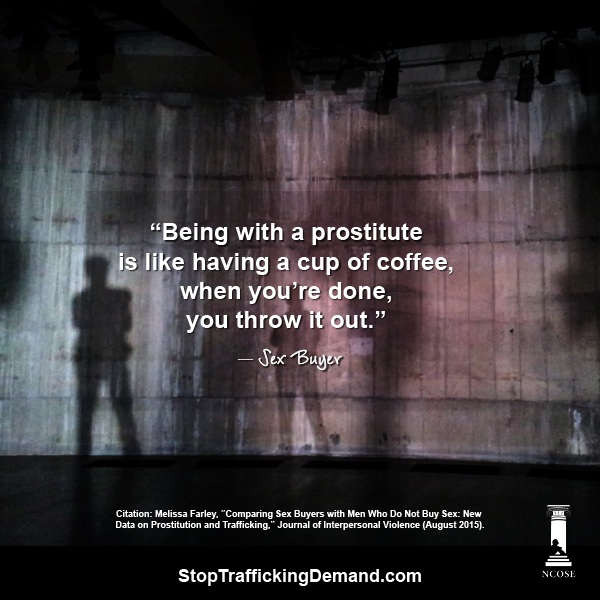
Being with a prostitute is like having a cup of coffee when you're done, you throw it out.
Sex Buyer
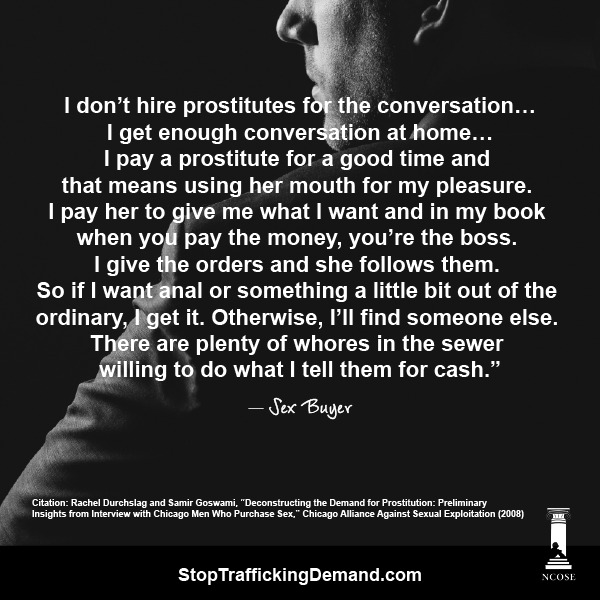
I don't hire prostitutes for the conversation... I get enough conversation at home... I pay a prostitute for a good time and that means using her mouth for my pleasure. I pay her to give me what I want and in my book when you pay the money, you're the boss.
I give the orders and she follows them. So if I want anal or something a little bit out of the ordinary, I get it. Otherwise, I'll find someone else. There are plenty of whores in the sewer willing to do what I tell them for cash.
Sex Buyer
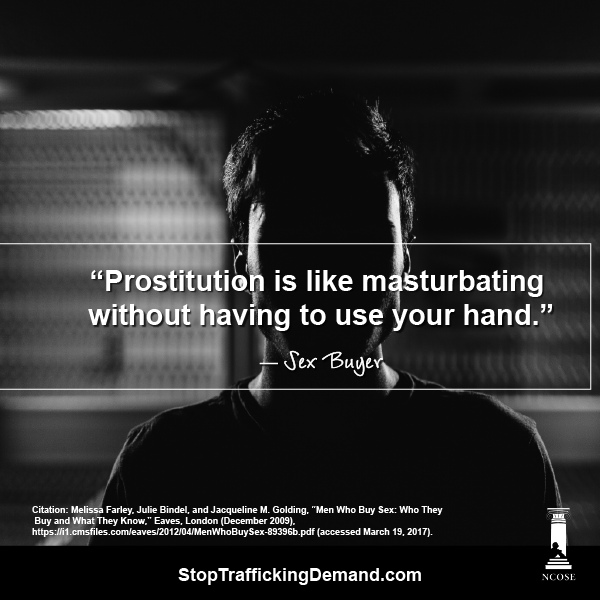
Prostitution is like masturbating without having to use your hand.
Sex Buyer
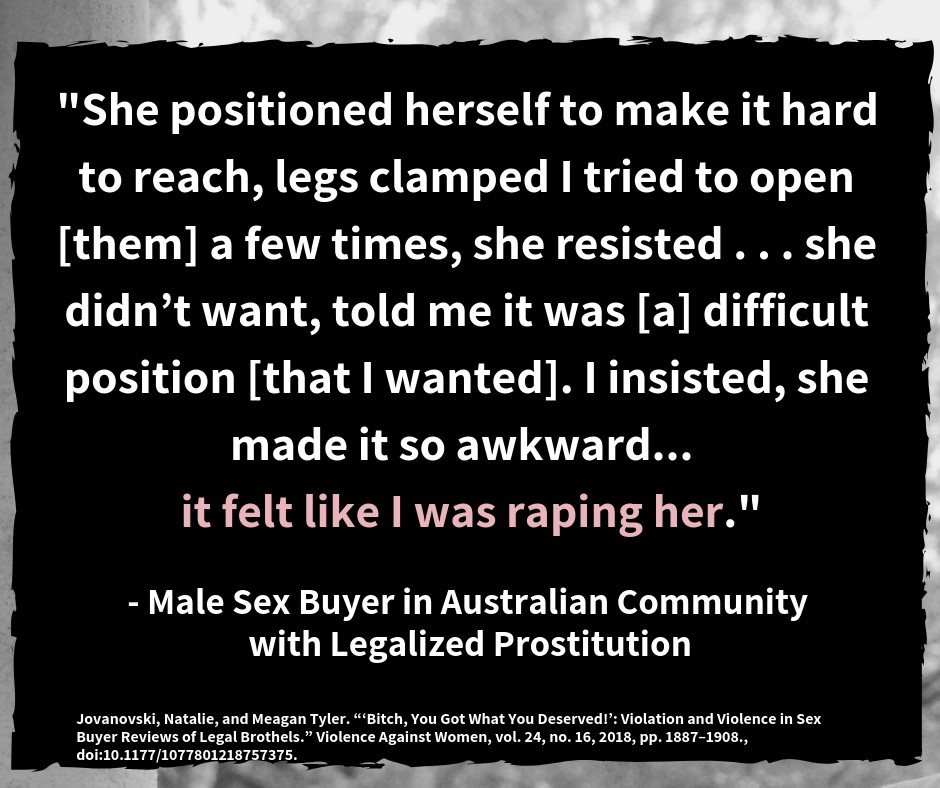
She positioned herself to make it hard to reach, legs clamped I tried to open [them] a few times, she resisted . . . she didn’t want, told me it was [a] difficult position [that I wanted]. I insisted, she made it so awkward...it felt like I was raping her.
Sex Buyer
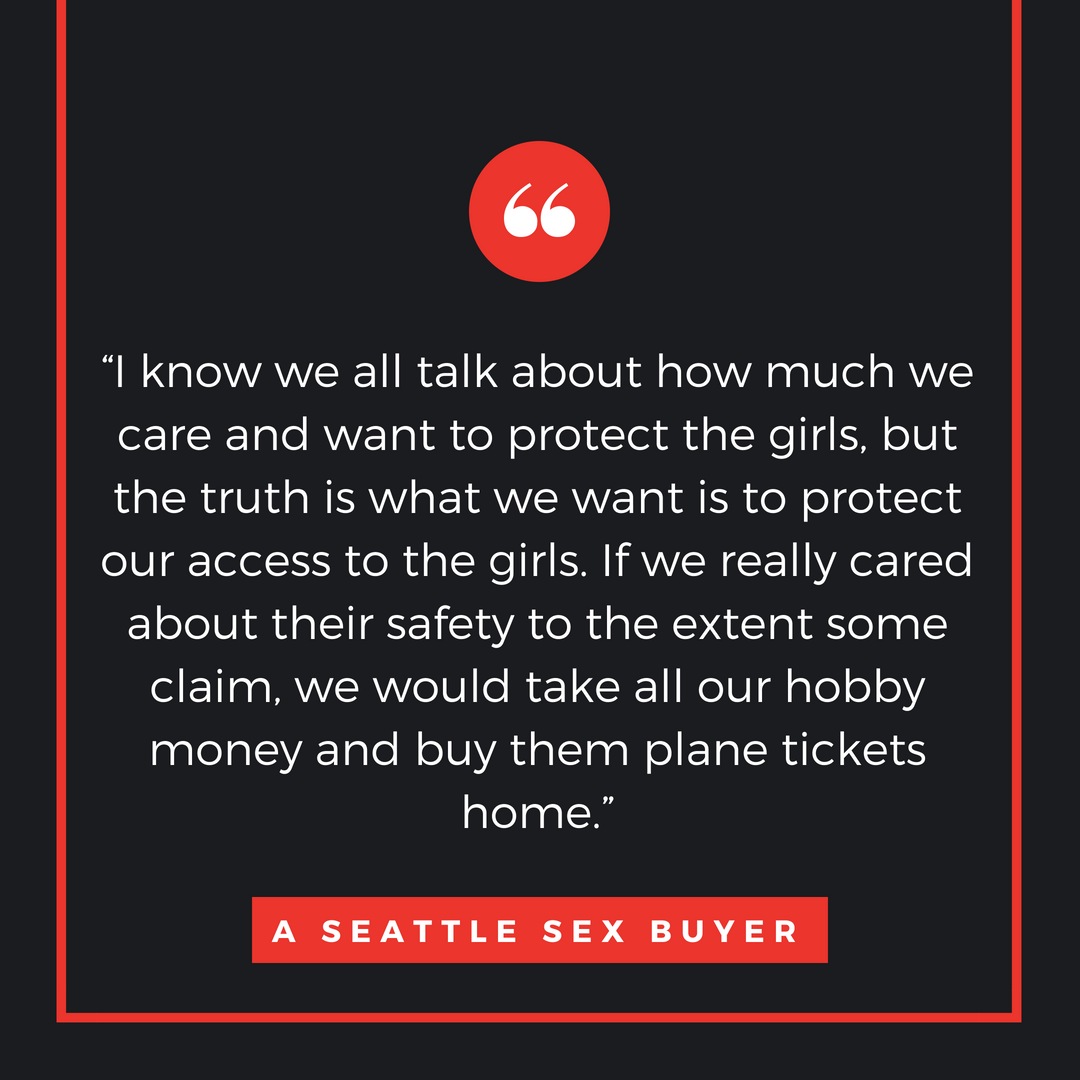
I know we all talk about how much we care and want to protect the girls, but the truth is what we want is to protect our access to the girls. If we really cared about their safety to the extent some claim, we would take all our 'hobby' money and buy them plane tickets home.
Sex Buyer
WARNING: Any pornographic images have been blurred, but are still suggestive. There may also be graphic text descriptions shown in these sections.
POSSIBLE TRIGGER.
Proof
Sex Trafficking & Coercive Tactics in Nevada Brothels
Coercion
It's important to recognize that literal force and fraud are not the only ways people end up in the sex trade. Psychological coercion from an being pimped/trafficked at an early age or early experiences of needing to rely on "survival sex" can prime an individual to remain stuck in the sex trade, believing that it is beneficial for them.
Further, legal brothels typically employ coercive tactics to control the women.
One survivor of 10 years in prostitution told the New York Times,
Women who worked in Nevada's legal brothels said they were like prisons where you have to turn tricks. Rimmed with high-security fencing and an electronic gate, they can look like a detention camp. The women live in lockdown conditions and can't leave the premises unless they're accompanied by a male pimp. Living and working in cramped, dark rooms, they're on call 24 hours a day. This is what happens when the law protects people who profit from commercial sexual exploitation. It’s the ideal business model. It's the best way to get a woman to turn as many tricks as possible.
Most of the women I knew in the brothels and escort services, had a history of trauma and abuse. I was homeless at the time I entered the life and, had multiple sclerosis. That vulnerability makes them even more easily victimized by pimps. And pimps don't stop being pimps when you legalize what they do. If we legalize brothels we'll only be giving these predators more power, while we help them protect their cash.
Further, women in brothels are pressured into having sex with customers or sometimes even brothel owners.
In one of the late Dennis Hof's legal brothels in Nevada one woman told another, “Well, you want Daddy to like you. You won’t have a very good time if he doesn’t, so if he wants you to [have sex with him], you definitely should.”
Sex Trafficking
One report noted:
About a third of the prostitutes who were issued work cards for Lyon County legal brothels last year had red flags on their application that should have been investigated further for possible human trafficking issues.
“This audit has exposed real weaknesses and gaps in the sheriff’s office ability to detect and deter foreign and domestic human trafficking into licensed brothels in Lyon County,” the sheriff’s presentation said...
Sheriff’s officials said the audit was prompted by public records requests for prostitute work card applications, and is the product of about 75 man hours.
The report noted a variety of red flags in the backgrounds of applicants that might suggest trafficking and should warrant further investigation. They included frequent moves, applying soon after moving into the U.S. and a criminal history related to illegal prostitution that might suggest they still are at the behest of a pimp.
Another report notes:
The audit also states that a “large majority of prostitutes report instability of residences and extensive criminal records that indicate property and other quality of life type crimes. Again, these are indicators for human trafficking and sexual exploitation.” The audit said “at a minimum, 83 prostitutes” positively indicated that they were part of human trafficking.
General County Citizens Profiting Off Sexploitation
Profits Throughout the Community:
Women in brothels typically have to give a large portion, often up to 50%, of their earnings to the brothels.
But they also need to give a percentage of their earnings to taxi cab drivers and limo drivers who bring sex buyers to the brothels, sometimes this goes up to 30% of the transaction. There is also an elaborate tip system where women tip errand-runners, cooks, cleaners, and more, regularly.
The brothels bring in tourists and sometimes employee local citizens, and thereby the communities profit off the system.
Funding Other Community Functions:
According to a pro-prostitution website, Lyon County brothels are some of the biggest donors, at "up to tens of thousands of dollars," to:
- Animal parks
- Food banks
- Sheriff’s ARK program
- Boys and girls club
- High School
- Toys for Tots
- $26K towards Silver Springs Renown Medical Center
- "We employ over 550 independent contractors every year and over 125 employees."
Lyon County Sheriff's Department Profiting Off Sexploitation
At least half a million dollars from Lyon County brothels go into funding the county every year, particularly for purchasing new cars for the Sheriff’s office.
Jeff Page, a Lyon County Executive quoted on a pro-prostitution website, stated:
“Brothels don’t pay business taxes, but contribute nearly $500,000 in other fees to the county which goes toward paying the county fleet of vehicles. With only 52,000 residents, the county would be hard pressed to make up that revenue if the brothels were banned. From a financial perspective, it means it has to come from someplace else.”
The pro-prostitution website goes on to say "Sheriff Sid Smith and Sheriff Allen Veil neither had an issue with the brothels in Lyon County."
Of course, it is not surprising that a Sheriff's office would not have a problem with a large source that pays for their vehicles.
One of the problems with legalizing prostitution is that prostitution begins to bring in money for the local or state government. When that happens, government employees are incentivized to maintain the brothel business.


